Bioelectromagnetism is a discipline that examines the electric, electromagnetic, and magnetic phenomena which arise in biological tissues.These phenomena include:
 It is important to separate the concept of bioelectromagnetism from the
concept of medical electronics; the former involves bioelectric,
bioelectromagnetic, and biomagnetic phenomena and measurement and
stimulation methodology, whereas the latter refers to the actual
devices used for these purposes.
It is important to separate the concept of bioelectromagnetism from the
concept of medical electronics; the former involves bioelectric,
bioelectromagnetic, and biomagnetic phenomena and measurement and
stimulation methodology, whereas the latter refers to the actual
devices used for these purposes.  By definition,
bioelectromagnetism is interdisciplinary since it involves the association of
the life sciences with the physical and engineering sciences. Consequently, we
have a special interest in those disciplines that combine engineering and
physics with biology and medicine. These disciplines are briefly defined as
follows:
By definition,
bioelectromagnetism is interdisciplinary since it involves the association of
the life sciences with the physical and engineering sciences. Consequently, we
have a special interest in those disciplines that combine engineering and
physics with biology and medicine. These disciplines are briefly defined as
follows:
 Biophysics: The science that is concerned with the solution of
biological problems in terms of the concepts of physics.
Biophysics: The science that is concerned with the solution of
biological problems in terms of the concepts of physics.  Bioengineering:
The application of engineering to the development of health care devices,
analysis of biological systems, and manufacturing of products based on advances
in this technology. This term is also frequently used to encompass both
biomedical engineering and biochemical engineering (biotechnology).
Bioengineering:
The application of engineering to the development of health care devices,
analysis of biological systems, and manufacturing of products based on advances
in this technology. This term is also frequently used to encompass both
biomedical engineering and biochemical engineering (biotechnology).  Biotechnology:
The study of microbiological process technology. The main fields of application
of biotechnology are agriculture, and food and drug production.
Biotechnology:
The study of microbiological process technology. The main fields of application
of biotechnology are agriculture, and food and drug production.  Medical
electronics: A division of biomedical engineering concerned with electronic
devices and methods in medicine.
Medical
electronics: A division of biomedical engineering concerned with electronic
devices and methods in medicine.  Medical
physics: A science based upon physical problems in clinical medicine.
Medical
physics: A science based upon physical problems in clinical medicine.
 Biomedical
engineering: An engineering discipline concerned with the application of
science and technology (devices and methods) to biology and medicine.
Biomedical
engineering: An engineering discipline concerned with the application of
science and technology (devices and methods) to biology and medicine.
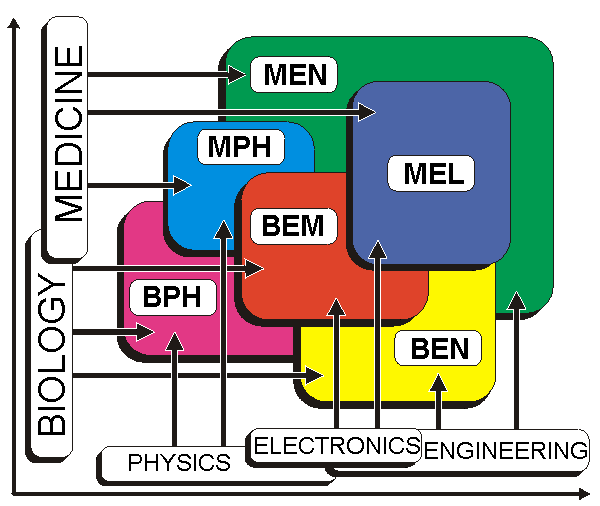
 BEN =
bioengineering,
BEN =
bioengineering,
 BPH =
biophysics,
BPH =
biophysics,
 BEM =
bioelectromagnetism,
BEM =
bioelectromagnetism,
 MPH = medical
physics,
MPH = medical
physics,
 MEN = medical
engineering,
MEN = medical
engineering,
 MEL = medical
electronics.
MEL = medical
electronics.
 Figure 1.1 illustrates the relationships between these disciplines. The
coordinate origin represents the more theoretical sciences, such as biology and
physics. As one moves away from the origin, the sciences become increasingly
applied. Combining a pair of sciences from medical and technical fields yields
interdisciplinary sciences such as medical engineering. It must be understood
that the disciplines are actually multidimensional, and thus their
two-dimensional description is only suggestive.
Figure 1.1 illustrates the relationships between these disciplines. The
coordinate origin represents the more theoretical sciences, such as biology and
physics. As one moves away from the origin, the sciences become increasingly
applied. Combining a pair of sciences from medical and technical fields yields
interdisciplinary sciences such as medical engineering. It must be understood
that the disciplines are actually multidimensional, and thus their
two-dimensional description is only suggestive.
1.2 SUBDIVISIONS OF BIOELECTROMAGNETISM
1.2.1 Division on a Theoretical Basis
The discipline of bioelectromagnetism may be subdivided in many
different ways. One such classification divides the field on theoretical grounds
according to two universal principles: Maxwell's equations (the
electromagnetic connection) and the principle of reciprocity. This
philosophy is illustrated in Figure 1.2 and is discussed in greater detail
below.
Maxwell's Equations Reciprocity
Description of the Subdivisions
Lead Field Theoretical Approach
Fig. 1.3. Lead field theoretical approach to describe
the subdivisions of bioelectromagnetism. The sensitivity distribution in the
detection of bioelectric signals, the energy distribution in electric
stimulation, and the distribution of measurement sensitivity of electric
impedance are the same, owing to the principle of reciprocity. This is true
also for the corresponding bioelectromagnetic and biomagnetic methods.
Maxwell's equations tie time-varying electric and magnetic fields together so
that when there are bioelectric fields there are also bioelectromagnetic
fields, and vice versa. 1.2.2 Division on an Anatomical Basis
Bioelectromagnetism can be classified also along anatomical
lines. This division is appropriate especially when one is discussing clinical
applications. In this case, bioelectromagnetism is subdivided according to the
applicable tissue. For example, one might consider
1.2.3 Organization of this Book
Because it is inappropriate from a didactic perspective to use
only one of the aforementioned divisional schemes (i.e.,division on a
theoretical or an anatomical basis), both of them are utilized in this book.
This book includes 28 chapters which are arranged into nine parts. Table 1.4
illustrates how these chapters fit into the scheme where by bioelectromagnetism
is divided on a theoretical basis, as introduced in Figure 1.2.
1.3 IMPORTANCE OF BIOELECTROMAGNETISM
Why should we consider the study of electric and magnetic
phenomena in living tissues as a separate discipline? The main reason is that
bioelectric phenomena of the cell membrane are vital functions of the living
organism. The cell uses the membrane potential in several ways. With rapid
opening of the channels for sodium ions, the membrane potential is altered
radically within a thousandth of a second. Cells in the nervous system
communicate with one another by means of such electric signals that rapidly
travel along the nerve processes. In fact, life itself begins with a change in
membrane potential. As the sperm merges with the egg cell at the instant of
fertilization, ion channels in the egg are activated. The resultant change in
the membrane potential prevents access of other sperm cells.
1.4 SHORT HISTORY OF BIOELECTROMAGNETISM
1.4.1 The First Written Documents and First Experiments in
Bioelectromagnetism
The first written document on bioelectric events is in an
ancient Egyptian hieroglyph of 4000 B.C. The hieroglyph describes the electric
sheatfish (catfish) as a fish that "releases the troops." Evidently, when the
catch included such a fish, the fish generated electric shocks with an amplitude
of more than 450 V, which forced the fishermen to release all of the fish. The
sheatfish is also illustrated in an Egyptian sepulcher fresco (Morgan, 1868).
Fig. 1.4. The first instrument to detect electricity
was the electroscope invented by William Gilbert. (Gilbert 1600).
Fig. 1.5. Stimulation experiment of Jan Swammerdam in
1664. Touching the motoric nerve of a frog muscle (b) in a glass vessel (a)
with silver wire (c) and a copper loop (d) produces stimulation of the nerve,
which elicits a muscular contraction; however, it is uncertain as to whether
the stimulation was produced as a result of electricity from the two
dissimilar metals or from the mechanical pinching. See also text. (Swammerdam,
1738.).
Fig. 1.6. Otto von Guericke constructed the first
electric machine which included a sphere of sulphur with an iron axle. When
rotating and rubbing the sphere it generated static electricity. (Guericke,
1672).
Fig. 1.7. Electric machine invented by Hauksbee in
1704. It had a sphere of glass rotated by a wheel. When the glass was rotated
and rubbed it produced electricity continuously. If the glass was evacuated
with air pump it generated brilliant light. (Hauksbee, 1709). 1.4.2 Electric and Magnetic Stimulation
Systematic application of electromedical equipment for
therapeutic use started in the 1700s. One can identify four different historical
periods of electromagnetic stimulation, each based on a specific type or origin
of electricity. These periods are named after Benjamin Franklin (American;
1706-1790), Luigi Galvani (Italian; 1737-1798), Michael Faraday (British;
1791-1867), and Jacques Arsène d'Arsonval (French; 1851-1940), as explained in
Table 1.5. These men were the discoverers or promoters of different kinds of
electricity: static electricity, direct current, induction coil shocks, and
radiofrequency current, respectively (Geddes, 1984a).
Fig. 1.8. The Leyden Jar, invented in 1745, was the
first storage of electricity. It is formed by a glass bottle covered with
metal foil on the inner and outer surfaces. (Krueger, 1746).
Fig. 1.9. Stimulation experiment of Luigi Galvani. The
electrochemical behavior of two dissimilar metals [(zinc (Z) and copper (C)]
in a bimetallic arch, in contact with the electrolytes of tissue, produces an
electric stimulating current that elicits muscular contraction.
Fig. 1.10. Induction coil with hammer break. Electric
current from the battery (E) is fed to the primary circuit of the induction
coil (A). This current pulls the hammer with the magnetic field of the
solenoid (close to G) and breaks the circuit with the contactor (D). Through
the vibration of the hammer this breaking is continuous and it induces a high
voltage alternating current in the secondary circuit in (A). This current is
applied to the patient with electrodes (H)..
1.4.3 Detection of Bioelectric Activity
The connection between electricity and magnetism was
discovered in 1819 by Hans Christian Örsted (Danish; 1777-1851). Örsted
conducted his first experiment during his lecture at the University of
Copenhagen. Passing an electric current through a wire above a magnetic needle,
he forced the needle to move to the direction normal to the wire (see Figure
1.12) (Örsted, 1820a,b,c). By reversing the direction of the electric current,
he reversed the direction of the needle deflection. (The magnetic needle, i.e.
the compass, was invented in China about A.D. 100 and is the first detector of
magnetic field.)
Fig. 1.12. Reconstruction of the first demonstration
of the electromagnetic connection by Hans Christian Örsted in 1819. The
battery generates an electric current I to flow in the circuit formed by a
metal wire. This current induces a magnetic induction around the wire. The
magnetic needle under the wire turns parallel to the direction of the magnetic
induction demonstrating its existence. (Örsted, 1820a,b,c). Fig. 1.13. (A) Astatic galvanometer invented by Nobili
in 1825. He compensated for the effect of the Earth's magnetic field by
placing two identical magnetic needles connected on the same suspension in
opposite directions in the openings of a coil wound in the form of figure
eight. (Nobili, 1825.) (B) A technically more advanced version of the astatic
galvanometer. Only one of the two identical (but opposite) needles is
surrounded by a coil. The other needle serves as an indicator.
The tracings of the electric activity of the human heart, the
electrocardiogram (ECG), was first measured in 1887 by Augustus Waller
(British; 1856-1922) using capillary electrometer (Waller, 1887; see
Figure 1.16). In a capillary electrometer a moving photographic film is exposed
along a glass capillary tube filled with sulphuric acid and mercury. Their
interface moves in response to an electric field. The sensitivity of the
capillary electrometer is about 1 mV, but its time response is very poor. The
capillary electrometer was invented in 1873 by Gabriel Lippman (1873), and the
photographic technique by which the signal was recorded by E. J. Marey and G. J.
Lippman (1876).
Fig. 1.16. The first recording of the human
electrocardiogram by Augustus Waller (1887). The recording was made with a
capillary electrometer. The ECG recording (e) is the borderline between the
black and white areas. The other curve (h) is the apexcardiogram, a
recording of the mechanical movement of the apex of the heart.
Fig. 1.17. Electric field of the heart on the surface
of the thorax, recorded by Augustus Waller (1887). The curves (a) and (b)
represent the recorded positive and negative isopotential lines, respectively.
These indicate that the heart is a dipolar source having the positive and
negative poles at (A) and (B), respectively. The curves (c) represent the
assumed current flow lines..
Fig. 1.18. The monocardiogram by Mann. (Redrawn from
Mann, 1920). 1.4.4 Modern Electrophysiological Studies of Neural Cells
The term neuron was first applied to the neural cell in
1891 by Heinrich Wilhelm Gottfried Waldeyer (German; 1837-1921). Basic research
into the study of neurons was undertaken at the end of the nineteenth century by
August Forel (Swiss; 1848-1931), Wilhelm His, Sr. (Swiss; 1831-1904), and
Santiago Ramón y Cajal (Spanish; 1852-1934). According to their theory, it is
the neural cell that is the functional unit in the nervous system. (In 1871,
Santiago Ramón y Cajal also discovered that neurons could be selectively stained
with a special silver preparation.) 1.4.5 Bioelectromagnetism
As mentioned in Section 1.4.3, the connection between
electricity and magnetism was experimentally discovered in 1819 by Hans
Christian Örsted. French scientists Jean Baptiste Biot (1774- 1862) and Félix
Savart (1791-1841) proved that the force between a current-carrying helical wire
and a magnet pole is inversely proportional to the distance between them (Biot,
1820). André Marie Ampère (French; 1775-1836) showed that a current-carrying
helical wire, which he called the solenoid, behaved magnetically as a
permanent magnet (Ampère, 1820), hence linking the electric current to the
production of a magnetic field. Ampère also developed the mathematical theory of
electrodynamics (Ampère, 1827). The electromagnetic connection was theoretically
formulated in 1864 by James Clerk Maxwell (British; 1831-79), who developed
equations that link time-varying electricity and magnetism (Maxwell, 1865).
Since Örsted's discovery, electromagnetic interdependence has been widely
utilized in a large variety of devices. Examples of these include those used for
the measurement of electric current (galvanometers and ammeters), electric
generators, electric motors, and various radiofrequency devices. However,
biomagnetic signals were not detected for a long time because of their extremely
low amplitude.
1.4.6 Theoretical Contributions to Bioelectromagnetism
The German scientist and philosopher Hermann Ludwig Ferdinand
von Helmholtz (1821-1894) made the earliest significant contributions of the
theory of bioelectromagnetism. A physician by education and, in 1849, appointed
professor of physiology at Königsberg, he moved to the chair of physiology at
Bonn in 1855. In 1871 he was awarded the chair of physics at the University of
Berlin, and in 1888 was also appointed the first director of
Physikalisch-Technische Bundesanstalt in Berlin.
1.4.7 Summary of the History of Bioelectromagnetism
The history of bioelectromagnetism is summarized
chronologically in Figure 1.20. The historical events are divided into four
groups: theory, instrumentation, stimulation, and measurements. This figure
should serve as a useful overview for our readers and help them recognize how
one contribution follows from an earlier one and how the development of an
entire discipline thereby takes place. From this figure we may summarize the
following thoughts.
1.5 NOBEL PRIZES IN BIOELECTROMAGNETISM
The discipline of bioelectromagnetism is strongly reflected in
the work of many Nobel laureates. It should be noted that 16 Nobel prizes have
been given for contributions to the discipline of bioelectromagnetism and
closely related subjects. Of these prizes, 12 were in physiology or medicine;
four were in chemistry. Although some perhaps do not directly concern
bioelectromagnetism, they are very closely related. Since several individuals
may have shared an award, the actual number of Nobel laureates is 28. The large
number of these Nobel laureates shows that bioelectromagnetism is recognized as
a very important discipline. Nobel laureates associated with bioelectromagnetism
are listed in Table 1.6.
Maxwell's equations, i.e.
the electromagnetic connection, connect time-varying electric and magnetic
fields so that when there are bioelectric fields there always are also
biomagnetic fields, and vice versa (Maxwell, 1865). Depending on whether
we discuss electric, electromagnetic, or magnetic phenomena, bioelectromagnetism
may be divided along one conceptual dimension (horizontally in Figure 1.2) into
three subdivisions, namely
 Subdivision B has historically been called "biomagnetism" which
unfortunately can be confused with our Subdivision C. Therefore, in this book,
for Subdivision B we also use the conventional name "biomagnetism" but, where
appropriate, we emphasize that the more precise term is "bioelectromagnetism."
(The reader experienced in electromagnetic theory will note the omission of a
logical fourth subdivision: measurement of the electric field induced by
variation in the magnetic field arising from magnetic material in tissue.
However, because this field is not easily detected and does not have any known
value, we have omitted it from our discussion).
Subdivision B has historically been called "biomagnetism" which
unfortunately can be confused with our Subdivision C. Therefore, in this book,
for Subdivision B we also use the conventional name "biomagnetism" but, where
appropriate, we emphasize that the more precise term is "bioelectromagnetism."
(The reader experienced in electromagnetic theory will note the omission of a
logical fourth subdivision: measurement of the electric field induced by
variation in the magnetic field arising from magnetic material in tissue.
However, because this field is not easily detected and does not have any known
value, we have omitted it from our discussion).
Owing to the principle of
reciprocity, the sensitivity distribution in the detection of bioelectric
signals, the energy distribution in electric stimulation, and the sensitivity
distribution of electric impedance measurements are the same. This is also true
for the corresponding bioelectromagnetic and biomagnetic methods, respectively.
Depending on whether we discuss the measurement of the field, of
stimulation/magnetization, or the measurement of intrinsic properties of tissue,
bioelectromagnetism may be divided within this framework (vertically in Figure
1.2) as follows:.
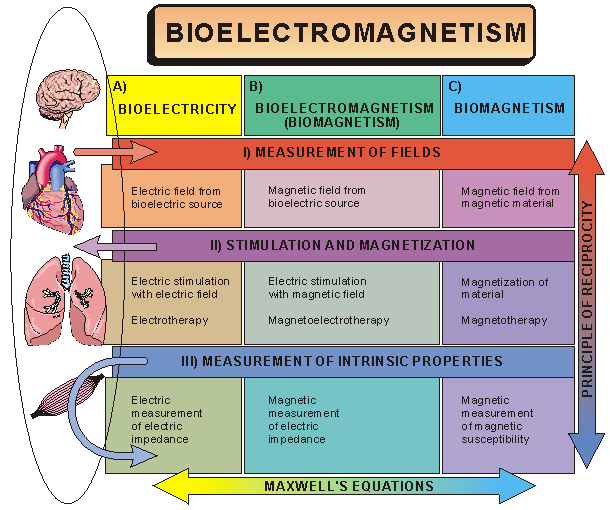
The
aforementioned taxonomy is illustrated in Figure 1.2 and a detailed description
of its elements is given in this section.  (I) Measurement of
an electric or a magnetic field refers, essentially, to the electric or
magnetic signals produced by the activity of living tissues. In this subdivision
of bioelectromagnetism, the active tissues produce electromagnetic energy, which
is measured either electrically or magnetically within or outside the organism
in which the source lies. This subdivision includes also the magnetic field
produced by magnetic material in the tissue. Examples of these fields in the
three horizontal subdivisions are shown in Table 1.1.
(I) Measurement of
an electric or a magnetic field refers, essentially, to the electric or
magnetic signals produced by the activity of living tissues. In this subdivision
of bioelectromagnetism, the active tissues produce electromagnetic energy, which
is measured either electrically or magnetically within or outside the organism
in which the source lies. This subdivision includes also the magnetic field
produced by magnetic material in the tissue. Examples of these fields in the
three horizontal subdivisions are shown in Table 1.1.
Table 1.1 I ) Measurements of fields
(A) Bioelectricity
(B)
Bioelectromagnetism
(Biomagnetism)(C) Biomagnetism
Neural cells
electroencephalography (EEG)
magnetoencephalography (MEG)
electroneurography (ENG)
magnetoneurography (MNG)
electroretinography (ERG)
magnetoretinography (MRG)
Muscle cells
electrocardiography (ECG)
magnetocardiography (MCG)
electromyography (EMG)
magnetomyography (MMG)
Other tissue
electro-oculography (EOG)
magneto-oculography (MOG)
electronystagmography (ENG)
magnetonystagmography (MNG)
magnetopneumogram
magnetohepatogram
 (II) Electric stimulation with an electric or a magnetic field or
the magnetization of materials includes the effects of applied electric and
magnetic fields on tissue. In this subdivision of bioelectromagnetism, electric
or magnetic energy is generated with an electronic device outside biological
tissues. When this electric or magnetic energy is applied to excitable
tissue in order to activate it, it is called electric stimulation or
magnetic stimulation, respectively. When the magnetic energy is applied
to tissue containing ferromagnetic material, the material is magnetized.
(To be accurate, an insulated human body may also be charged to a high electric
potential. This kind of experiment, called electrifying, were made
already during the early development of bioelectricity but their value is only
in the entertainment.) Similarly the nonlinear membrane properties may be
defined with both subthreshold and transthreshold stimuli. Subthreshold electric
or magnetic energy may also be applied for other therapeutic purposes, called
electrotherapy or magnetotherapy. Examples of this second
subdivision of bioelectromagnetism, also called electrobiology and
magnetobiology, respectively, are shown in Table 1.2.
(II) Electric stimulation with an electric or a magnetic field or
the magnetization of materials includes the effects of applied electric and
magnetic fields on tissue. In this subdivision of bioelectromagnetism, electric
or magnetic energy is generated with an electronic device outside biological
tissues. When this electric or magnetic energy is applied to excitable
tissue in order to activate it, it is called electric stimulation or
magnetic stimulation, respectively. When the magnetic energy is applied
to tissue containing ferromagnetic material, the material is magnetized.
(To be accurate, an insulated human body may also be charged to a high electric
potential. This kind of experiment, called electrifying, were made
already during the early development of bioelectricity but their value is only
in the entertainment.) Similarly the nonlinear membrane properties may be
defined with both subthreshold and transthreshold stimuli. Subthreshold electric
or magnetic energy may also be applied for other therapeutic purposes, called
electrotherapy or magnetotherapy. Examples of this second
subdivision of bioelectromagnetism, also called electrobiology and
magnetobiology, respectively, are shown in Table 1.2.
Table 1.2 II ) Stimulation and magnetization
(A) Bioelectricity
(B)
Bioelectromagnetism
(Biomagnetism)(C) Biomagnetism
Stimulation
patch clamp, voltage clamp
electric stimulation of
magnetic stimulation of
electric cardiac pacing
magnetic cardiac pacing
electric cardiac defibrillation
magnetic cardiac defibrillation
Therapeutic applications
electrotherapy
electromagnetotherapy
magnetotherapy
electrosurgery
Magnetization
magnetization of
ferromagnetic
material
 (III) Measurement of the intrinsic electric or magnetic properties
of tissue is included in bioelectromagnetism as a third subdivision. As in
Subdivision II, electric or magnetic energy is generated by an electronic device
outside the biological tissue and applied to it. However, when the strength of
the energy is subthreshold, the passive (intrinsic) electric and magnetic
properties of the tissue may be obtained by performing suitable measurements.
Table 1.3 illustrates this subdivision:
(III) Measurement of the intrinsic electric or magnetic properties
of tissue is included in bioelectromagnetism as a third subdivision. As in
Subdivision II, electric or magnetic energy is generated by an electronic device
outside the biological tissue and applied to it. However, when the strength of
the energy is subthreshold, the passive (intrinsic) electric and magnetic
properties of the tissue may be obtained by performing suitable measurements.
Table 1.3 illustrates this subdivision:
Table 1.3 III ) Measurement of intrinsic properties
(A) Bioelectricity
(B)
Bioelectromagnetism
(Biomagnetism)(C) Biomagnetism
electric measurement of
electric
impedancemagnetic measurement of
electric
impedancemeasurement of magnetic
susceptibility
impedance cardiography
magnetic susceptibility
plethysmography
impedance pneumography
magnetic remanence measurement
impedance tomography
impedance tomography
magnetic resonance imaging (MRI)
electrodermal response (EDR)
As noted in
the beginning of Section 1.2.1, Maxwell's equations connect time-varying
electric and magnetic fields, so that when there are bioelectric fields there
are also biomagnetic fields, and vice versa. This electromagnetic connection is
the universal principle unifying the three subdivisions - A, B, and C - of
bioelectromagnetism in the horizontal direction in Figure 1.2. As noted in the
beginning of this section, the sensitivity distribution in the detection of
bioelectric signals, the energy distribution in electric stimulation, and the
sensitivity distribution of the electric impedance measurement are the same. All
of this is true also for the corresponding bioelectromagnetic and biomagnetic
methods, respectively. The universal principle that ties together the three
subdivisions I, II, and III and unifies the discipline of bioelectromagnetism in
the vertical direction in Figure 1.2 is the principle of reciprocity.  These fundamental
principles are further illustrated in Figure 1.3, which is drawn in the same
format as Figure 1.2 but also includes a description of the applied methods and
the lead fields that characterize their sensitivity/energy distributions.
Before finishing this book, the reader may have difficulty understanding Figure
1.3 in depth. However, we wanted to introduce this figure early, because it
illustrates the fundamental principles governing the entire discipline of
bioelectromagnetism, which will be amplified later on..
These fundamental
principles are further illustrated in Figure 1.3, which is drawn in the same
format as Figure 1.2 but also includes a description of the applied methods and
the lead fields that characterize their sensitivity/energy distributions.
Before finishing this book, the reader may have difficulty understanding Figure
1.3 in depth. However, we wanted to introduce this figure early, because it
illustrates the fundamental principles governing the entire discipline of
bioelectromagnetism, which will be amplified later on..
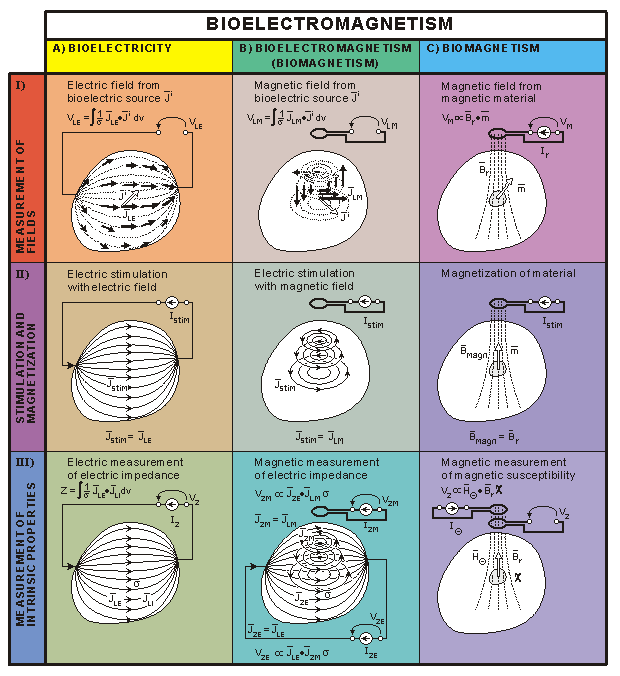
 Part I discusses the
anatomical and physiological basis of bioelectromagnetism. From the anatomical
perspective, for example, Part I considers bioelectric phenomena first on a
cellular level (i.e., involving nerve and muscle cells) and then on an organ
level (involving the nervous system (brain) and the heart).
Part I discusses the
anatomical and physiological basis of bioelectromagnetism. From the anatomical
perspective, for example, Part I considers bioelectric phenomena first on a
cellular level (i.e., involving nerve and muscle cells) and then on an organ
level (involving the nervous system (brain) and the heart).  Part II introduces the
concepts of the volume source and volume conductor and the concept
of modeling. It also introduces the concept of impressed current source
and discusses general theoretical concepts of source-field models and the
bidomain volume conductor. These discussions consider only electric
concepts.
Part II introduces the
concepts of the volume source and volume conductor and the concept
of modeling. It also introduces the concept of impressed current source
and discusses general theoretical concepts of source-field models and the
bidomain volume conductor. These discussions consider only electric
concepts.  Part III explores theoretical methods and thus anatomical features are
excluded from discussion. For practical (and historical) reasons, this
discussion is first presented from an electric perspective in Chapter 11.
Chapter 12 then relates most of these theoretical methods to magnetism and
especially considers the difference between concepts in electricity and
magnetism.
Part III explores theoretical methods and thus anatomical features are
excluded from discussion. For practical (and historical) reasons, this
discussion is first presented from an electric perspective in Chapter 11.
Chapter 12 then relates most of these theoretical methods to magnetism and
especially considers the difference between concepts in electricity and
magnetism.  The rest of the book (i.e., Parts IV - IX) explores clinical
applications. For this reason, bioelectromagnetism is first classified on an
anatomical basis into bioelectric and bio(electro)magnetic constituents to point
out the parallelism between them. Part IV describes electric and magnetic
measurements of bioelectric sources of the nervous system, and Part V those of
the heart.
The rest of the book (i.e., Parts IV - IX) explores clinical
applications. For this reason, bioelectromagnetism is first classified on an
anatomical basis into bioelectric and bio(electro)magnetic constituents to point
out the parallelism between them. Part IV describes electric and magnetic
measurements of bioelectric sources of the nervous system, and Part V those of
the heart.  In
Part VI, Chapters 21 and 22 discuss electric and magnetic stimulation of neural
and Part VII, Chapters 23 and 24, that of cardiac tissue. These subfields are
also referred to as electrobiology and magnetobiology.
In
Part VI, Chapters 21 and 22 discuss electric and magnetic stimulation of neural
and Part VII, Chapters 23 and 24, that of cardiac tissue. These subfields are
also referred to as electrobiology and magnetobiology.  Part VIII focuses on
Subdivision III of bioelectromagnetism - that is, the measurement of the
intrinsic electric properties of biological tissue. Chapters 25 and 26 examine
the measurement and imaging of tissue impedance, and Chapter 27 the measurement
of the electrodermal response.
Part VIII focuses on
Subdivision III of bioelectromagnetism - that is, the measurement of the
intrinsic electric properties of biological tissue. Chapters 25 and 26 examine
the measurement and imaging of tissue impedance, and Chapter 27 the measurement
of the electrodermal response.  In Part IX, Chapter 28
introduces the reader to a bioelectric signal that is not generated by excitable
tissue: the electro-oculogram (EOG). The electroretinogram (ERG) also is
discussed in this connection for anatomical reasons, although the signal is due
to an excitable tissue, namely the retina.
In Part IX, Chapter 28
introduces the reader to a bioelectric signal that is not generated by excitable
tissue: the electro-oculogram (EOG). The electroretinogram (ERG) also is
discussed in this connection for anatomical reasons, although the signal is due
to an excitable tissue, namely the retina.  The discussion of the
effects of an electromagnetic field on the tissue, which is part of Subdivision
II, includes topics on cellular physiology and pathology rather than
electromagnetic theory. Therefore this book does not include this subject. The
reader may get an overview of this for instance from (Gandhi, 1990; Reilly,
1992).
The discussion of the
effects of an electromagnetic field on the tissue, which is part of Subdivision
II, includes topics on cellular physiology and pathology rather than
electromagnetic theory. Therefore this book does not include this subject. The
reader may get an overview of this for instance from (Gandhi, 1990; Reilly,
1992).
Table 1.4 Organization of this book (by chapter number)
according to the division of bioelectromagnetism
on a theoretical
basis.
(A) Bioelectricity
(B)
Bioelectromagnetism
(Biomagnetism)(C) Biomagnetism
(I) Measurement of fields
Electric field from
bioelectric sourceMagnetic field from
bioelectric sourceMagnetic field from
magnetic material
04 Active behavior of the membrane
05 Physiology of the
synapse and brain
06 Bioelectric behavior of the heart
07
Volume source and volume conductor
08 Source-field models
09
Bidomain model
11 Theoretical methods
13
Electroencephalography
15 12-lead ECG
16
Vectorcardiography
17 Other ECG systems
18 Distortion in
ECG
19 ECG diagnosis
28 Electric signals of the eye
12
Theory of biomagnetic measurements
14
Magnetoencephalography
20 Magnetocardiography Not discussed
(II) Stimulation and magnetization
Electric stimulation
with electric fieldElectric stimulation
with magnetic fieldMagnetization of material
03 Subthreshold membrane phenomena
21 Functional electric
stimulation
23 Cardiac pacing
24 Cardiac defibrillation
22 Magnetic stimulation Not discussed
(III) Measurement of intrinsic properties
Electric measurement of
electric impedanceMagnetic measurement of
electric impedanceMagnetic measurement of
magnetic susceptibility
25 Impedance plethysmography
26 Impedance tomography
27
Electrodermal response
26 Magnetic measurement of
electric
impedance tomography Not discussed
 Because discussion of Subdivision C would require the introduction of
additional fundamentals, we have chosen not to include it in this volume. As
mentioned earlier, Subdivision C entails measurement of the magnetic field from
magnetic material, magnetization of material, and measurement of magnetic
susceptibility. The reader interested in these topics should consult Maniewski
et al. (1988) and other sources. At the present time, interest in the
Subdivision C topic is limited.
Because discussion of Subdivision C would require the introduction of
additional fundamentals, we have chosen not to include it in this volume. As
mentioned earlier, Subdivision C entails measurement of the magnetic field from
magnetic material, magnetization of material, and measurement of magnetic
susceptibility. The reader interested in these topics should consult Maniewski
et al. (1988) and other sources. At the present time, interest in the
Subdivision C topic is limited.
 Electric phenomena are
easily measured, and therefore, this approach is direct and feasible. In the
investigation of other modalities, such as biochemical and biophysical events,
special transducers must be used to convert the phenomenon of interest into a
measurable electric signal. In contrast electric phenomena can easily be
directly measured with simple electrodes; alternatively, the magnetic field they
produce can be detected with a magnetometer.
Electric phenomena are
easily measured, and therefore, this approach is direct and feasible. In the
investigation of other modalities, such as biochemical and biophysical events,
special transducers must be used to convert the phenomenon of interest into a
measurable electric signal. In contrast electric phenomena can easily be
directly measured with simple electrodes; alternatively, the magnetic field they
produce can be detected with a magnetometer.  In contrast to all
other biological variables, bioelectric and biomagnetic phenomena can be
detected in real time by noninvasive methods because the information obtained
from them is manifested immediately throughout and around the volume conductor
formed by the body. Their source may be investigated by applying the modern
theory of volume sources and volume conductors, utilizing the computing
capability of modern computers. (The concepts of volume sources and volume
conductors denote three-dimensional sources and conductors, respectively, having
large dimensions relative to the distance of the measurement. These are
discussed in detail later.) Conversely, it is possible to introduce temporally
and spatially controlled electric stimuli to activate paralyzed regions of the
neural or muscular systems of the body.
In contrast to all
other biological variables, bioelectric and biomagnetic phenomena can be
detected in real time by noninvasive methods because the information obtained
from them is manifested immediately throughout and around the volume conductor
formed by the body. Their source may be investigated by applying the modern
theory of volume sources and volume conductors, utilizing the computing
capability of modern computers. (The concepts of volume sources and volume
conductors denote three-dimensional sources and conductors, respectively, having
large dimensions relative to the distance of the measurement. These are
discussed in detail later.) Conversely, it is possible to introduce temporally
and spatially controlled electric stimuli to activate paralyzed regions of the
neural or muscular systems of the body.  The electric nature of
biological tissues permits the transmission of signals for information and for
control and is therefore of vital importance for life. The first category
includes such examples as vision, audition, and tactile sensation; in these
cases a peripheral transducer (the eye, the ear, etc.) initiates afferent
signals to the brain. Efferent signals originating in the brain can result in
voluntary contraction of muscles to effect the movement of limbs, for example.
And finally, homeostasis involves closed-loop regulation mediated, at least in
part, by electric signals that affect vital physiologic functions such as heart
rate, strength of cardiac contraction, humoral release, and so on.
The electric nature of
biological tissues permits the transmission of signals for information and for
control and is therefore of vital importance for life. The first category
includes such examples as vision, audition, and tactile sensation; in these
cases a peripheral transducer (the eye, the ear, etc.) initiates afferent
signals to the brain. Efferent signals originating in the brain can result in
voluntary contraction of muscles to effect the movement of limbs, for example.
And finally, homeostasis involves closed-loop regulation mediated, at least in
part, by electric signals that affect vital physiologic functions such as heart
rate, strength of cardiac contraction, humoral release, and so on.  As a result of the
rapid development of electronic instrumentation and computer science, diagnostic
instruments, which are based on bioelectric phenomena, have developed very
quickly. Today it is impossible to imagine any hospital or doctor's office
without electrocardiography and electroencephalography. The development of
microelectronics has made such equipment portable and strengthened their
diagnostic power. Implantable cardiac pacemakers have allowed millions of people
with heart problems to return to normal life. Biomagnetic applications are
likewise being rapidly developed and will, in the future, supplement bioelectric
methods in medical diagnosis and therapy. These examples illustrate that
bioelectromagnetism is a vital part of our everyday life.
As a result of the
rapid development of electronic instrumentation and computer science, diagnostic
instruments, which are based on bioelectric phenomena, have developed very
quickly. Today it is impossible to imagine any hospital or doctor's office
without electrocardiography and electroencephalography. The development of
microelectronics has made such equipment portable and strengthened their
diagnostic power. Implantable cardiac pacemakers have allowed millions of people
with heart problems to return to normal life. Biomagnetic applications are
likewise being rapidly developed and will, in the future, supplement bioelectric
methods in medical diagnosis and therapy. These examples illustrate that
bioelectromagnetism is a vital part of our everyday life.  Bioelectromagnetism
makes it possible to investigate the behavior of living tissue on both cellular
and organic levels. Furthermore, the latest scientific achievements now allow
scientists to do research at the subcellular level by measuring the electric
current flowing through a single ion channel of the cell membrane with the
patch-clamp method. With the latter approach, bioelectromagnetism can be applied
to molecular biology and to the development of new pharmaceuticals. Thus
bioelectromagnetism offers new and important opportunities for the development
of diagnostic and therapeutic methods.
Bioelectromagnetism
makes it possible to investigate the behavior of living tissue on both cellular
and organic levels. Furthermore, the latest scientific achievements now allow
scientists to do research at the subcellular level by measuring the electric
current flowing through a single ion channel of the cell membrane with the
patch-clamp method. With the latter approach, bioelectromagnetism can be applied
to molecular biology and to the development of new pharmaceuticals. Thus
bioelectromagnetism offers new and important opportunities for the development
of diagnostic and therapeutic methods.
 The Greek
philosophers Aristotle (384-322 B.C.) and Thales (c.625-547 B.C.) experimented
with amber and recognized its power to attract light substances (Smith, 1931).
The first written document on the medical application of electricity is from the
year A.D. 46, when Scribonius Largus recommended the use of torpedo fish for
curing headaches and gouty arthritis (Kellaway, 1946). The electric fish
remained the only means of producing electricity for electrotherapeutic
experiments until the seventeenth century.
The Greek
philosophers Aristotle (384-322 B.C.) and Thales (c.625-547 B.C.) experimented
with amber and recognized its power to attract light substances (Smith, 1931).
The first written document on the medical application of electricity is from the
year A.D. 46, when Scribonius Largus recommended the use of torpedo fish for
curing headaches and gouty arthritis (Kellaway, 1946). The electric fish
remained the only means of producing electricity for electrotherapeutic
experiments until the seventeenth century.  William Gilbert
(1544-1603), physician to Queen Elizabeth I of England, was the first to subject
the attractive power of amber to planned experiment. Gilbert constructed the
first instrument to measure this power. This electroscope was a light
metal needle pivoted on a pin so that it would turn toward the substances of
attracting power (see Figure 1.4). Gilbert called the substances possessing this
power of attraction electricks, from the Greek name for amber (elektron). Thus he coined the term that
eventually became the new science of electricity. Gilbert published his
experiments in 1600 in a book entitled De Magnete (Gilbert, 1600). (The
reader may refer to Figure 1.20 at the end of this chapter. It presents a
chronology of important historical events in bioelectromagnetism from the year
1600 until today.)
William Gilbert
(1544-1603), physician to Queen Elizabeth I of England, was the first to subject
the attractive power of amber to planned experiment. Gilbert constructed the
first instrument to measure this power. This electroscope was a light
metal needle pivoted on a pin so that it would turn toward the substances of
attracting power (see Figure 1.4). Gilbert called the substances possessing this
power of attraction electricks, from the Greek name for amber (elektron). Thus he coined the term that
eventually became the new science of electricity. Gilbert published his
experiments in 1600 in a book entitled De Magnete (Gilbert, 1600). (The
reader may refer to Figure 1.20 at the end of this chapter. It presents a
chronology of important historical events in bioelectromagnetism from the year
1600 until today.)
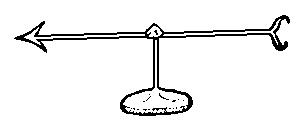
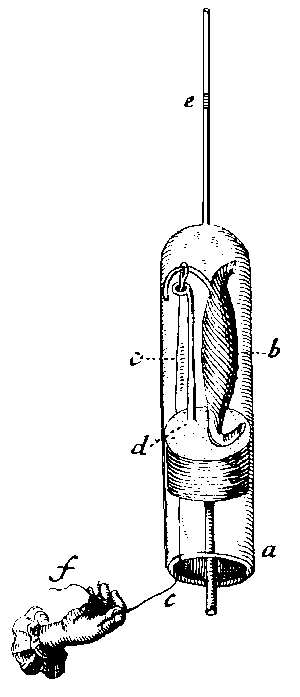
 In many similar experiments, Swammerdam stimulated the motor nerve by
pinching it. In fact, in this experiment stimulation was achieved by pulling the
nerve with a wire (c) made of silver (filium argenteum) against a loop (d) made
of copper (filium aeneum). According to the principles of electrochemistry, the
dissimilar metals in this experiment, which are embedded in the electrolyte
provided by the tissue, are the origin of an electromotive force (emf) and an
associated electric current. The latter flows through the metals and the tissue,
and is responsible for the stimulation (activation) of the nerve in this tissue
preparation. The nerve, once activated, initiates a flow of current of its own.
These are of biological origin, driven from sources that lie in the nerve and
muscle membranes, and are distinct from the aforementioned stimulating currents.
The active region of excitation propagates from the nerve to the muscle and is
the immediate cause of the muscle contraction. The electric behavior of nerve
and muscle forms the subject matter of "bioelectricity," and is one central
topic in this book.
In many similar experiments, Swammerdam stimulated the motor nerve by
pinching it. In fact, in this experiment stimulation was achieved by pulling the
nerve with a wire (c) made of silver (filium argenteum) against a loop (d) made
of copper (filium aeneum). According to the principles of electrochemistry, the
dissimilar metals in this experiment, which are embedded in the electrolyte
provided by the tissue, are the origin of an electromotive force (emf) and an
associated electric current. The latter flows through the metals and the tissue,
and is responsible for the stimulation (activation) of the nerve in this tissue
preparation. The nerve, once activated, initiates a flow of current of its own.
These are of biological origin, driven from sources that lie in the nerve and
muscle membranes, and are distinct from the aforementioned stimulating currents.
The active region of excitation propagates from the nerve to the muscle and is
the immediate cause of the muscle contraction. The electric behavior of nerve
and muscle forms the subject matter of "bioelectricity," and is one central
topic in this book.  It is believed that this was the first documented experiment of motor
nerve stimulation resulting from an emf generated at a bimetallic junction
(Brazier, 1959). Swammerdam probably did not understand that neuromuscular
excitation is an electric phenomenon. On the other hand, some authors interpret
the aforementioned stimulation to have resulted actually from the mechanical
stretching of the nerve. The results of this experiment were published
posthumously in 1738 (Swammerdam, 1738).
It is believed that this was the first documented experiment of motor
nerve stimulation resulting from an emf generated at a bimetallic junction
(Brazier, 1959). Swammerdam probably did not understand that neuromuscular
excitation is an electric phenomenon. On the other hand, some authors interpret
the aforementioned stimulation to have resulted actually from the mechanical
stretching of the nerve. The results of this experiment were published
posthumously in 1738 (Swammerdam, 1738).  The first electric
machine was constructed by Otto von Guericke (German; 1602-1686). It was a
sphere of sulphur ("the size of an infant's head") with an iron axle mounted in
a wooden framework, as illustrated in Figure 1.6. When the sphere was rotated
and rubbed, it generated static electricity (von Guericke, 1672). The second
electric machine was invented in 1704 by Francis Hauksbee the Elder (British;
1666-1713). It was a sphere of glass rotated by a wheel (see Figure 1.7). When
the rotating glass was rubbed, it produced electricity continuously (Hauksbee,
1709). It is worth mentioning that Hauksbee also experimented with evacuating
the glass with an air pump and was able to generate brilliant light, thus
anticipating the discovery of cathode rays, x-rays, and the
electron.
The first electric
machine was constructed by Otto von Guericke (German; 1602-1686). It was a
sphere of sulphur ("the size of an infant's head") with an iron axle mounted in
a wooden framework, as illustrated in Figure 1.6. When the sphere was rotated
and rubbed, it generated static electricity (von Guericke, 1672). The second
electric machine was invented in 1704 by Francis Hauksbee the Elder (British;
1666-1713). It was a sphere of glass rotated by a wheel (see Figure 1.7). When
the rotating glass was rubbed, it produced electricity continuously (Hauksbee,
1709). It is worth mentioning that Hauksbee also experimented with evacuating
the glass with an air pump and was able to generate brilliant light, thus
anticipating the discovery of cathode rays, x-rays, and the
electron.
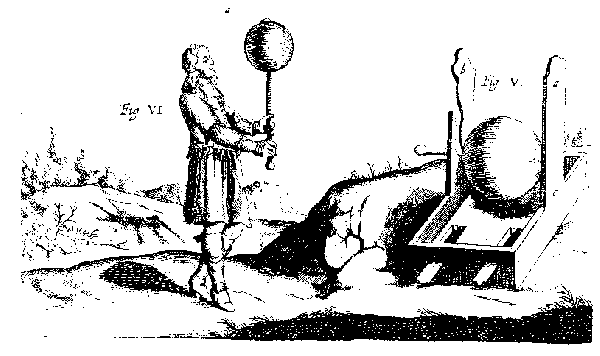
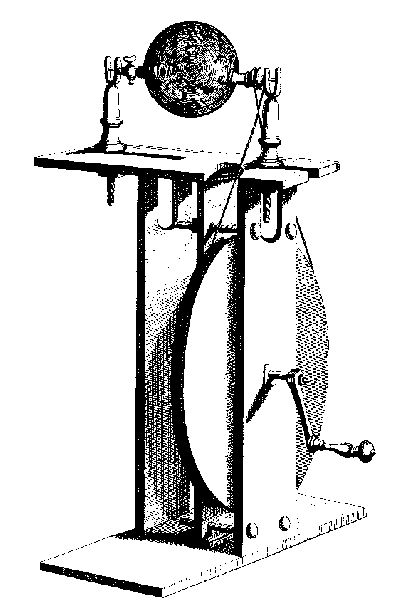
 At that time the main use of electricity was for entertainment and
medicine. One of the earliest statements concerning the use of electricity was
made in 1743 by Johann Gottlob Krüger of the University of Halle: "All things
must have a usefulness; that is certain. Since electricity must have a
usefulness, and we have seen that it cannot be looked for either in theology or
in jurisprudence, there is obviously nothing left but medicine." (Licht, 1967).
At that time the main use of electricity was for entertainment and
medicine. One of the earliest statements concerning the use of electricity was
made in 1743 by Johann Gottlob Krüger of the University of Halle: "All things
must have a usefulness; that is certain. Since electricity must have a
usefulness, and we have seen that it cannot be looked for either in theology or
in jurisprudence, there is obviously nothing left but medicine." (Licht, 1967).
Table 1.5. Different historical eras of electric and
electromagnetic stimulation.
Scientist
Lifetime
Historical era
Benjamin Franklin
1706-1790
static electricity
Luigi Galvani
1737-1798
direct current
Michael Faraday
1791-1867
induction coil shocks
Jacques d'Arsonval
1851-1940
radiofrequency current
 The essential invention necessary for the application of a stimulating
electric current was the Leyden jar. It was invented on the 11th of
October, in 1745 by German inventor Ewald Georg von Kleist (c. 1700-1748)
(Krueger, 1746). It was also invented independently by a Dutch scientist, Pieter
van Musschenbroek (1692-1761) of the University of Leyden in The Netherlands in
1746, whose university affiliation explains the origin of the name. The Leyden
jar is a capacitor formed by a glass bottle covered with metal foil on the inner
and outer surfaces, as illustrated in Figure 1.8. The first practical
electrostatic generator was invented by Jesse Ramsden (British;
1735-1800) in 1768 (Mottelay, 1975).
The essential invention necessary for the application of a stimulating
electric current was the Leyden jar. It was invented on the 11th of
October, in 1745 by German inventor Ewald Georg von Kleist (c. 1700-1748)
(Krueger, 1746). It was also invented independently by a Dutch scientist, Pieter
van Musschenbroek (1692-1761) of the University of Leyden in The Netherlands in
1746, whose university affiliation explains the origin of the name. The Leyden
jar is a capacitor formed by a glass bottle covered with metal foil on the inner
and outer surfaces, as illustrated in Figure 1.8. The first practical
electrostatic generator was invented by Jesse Ramsden (British;
1735-1800) in 1768 (Mottelay, 1975).  Benjamin Franklin
deduced the concept of positive and negative electricity in 1747 during
his experiments with the Leyden jar. Franklin also studied atmospheric
electricity with his famous kite experiment in 1752.
Benjamin Franklin
deduced the concept of positive and negative electricity in 1747 during
his experiments with the Leyden jar. Franklin also studied atmospheric
electricity with his famous kite experiment in 1752.  Soon after the Leyden
jar was invented, it was applied to muscular stimulation and treatment of
paralysis. As early as 1747, Jean Jallabert (Italian; 1712-1768), professor of
mathematics in Genova, applied electric stimulation to a patient whose hand was
paralyzed. The treatment lasted three months and was successful. This
experiment,which was carefully documented (Jallabert, 1748), represents the
beginning of therapeutic stimulation of muscles by electricity.
Soon after the Leyden
jar was invented, it was applied to muscular stimulation and treatment of
paralysis. As early as 1747, Jean Jallabert (Italian; 1712-1768), professor of
mathematics in Genova, applied electric stimulation to a patient whose hand was
paralyzed. The treatment lasted three months and was successful. This
experiment,which was carefully documented (Jallabert, 1748), represents the
beginning of therapeutic stimulation of muscles by electricity.
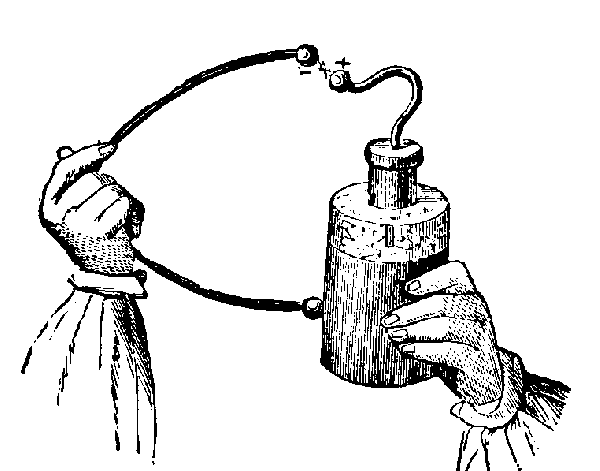
 The most famous experiments in neuromuscular stimulation were performed
by Luigi Galvani, professor of anatomy at the University of Bologna. His first
important finding is dated January 26, 1781. A dissected and prepared frog was
lying on the same table as an electric machine. When his assistant touched with
a scalpel the femoral nerve of the frog sparks were simultaneously discharged in
the nearby electric machine, and violent muscular contractions occurred
(Galvani, 1791; Rowbottom and Susskind, 1984, p. 35). (It has been suggested
that the assistant was Galvani's wife Lucia, who is known to have helped him
with his experiments.) This is cited as the first documented experiment in
neuromuscular electric stimulation.
The most famous experiments in neuromuscular stimulation were performed
by Luigi Galvani, professor of anatomy at the University of Bologna. His first
important finding is dated January 26, 1781. A dissected and prepared frog was
lying on the same table as an electric machine. When his assistant touched with
a scalpel the femoral nerve of the frog sparks were simultaneously discharged in
the nearby electric machine, and violent muscular contractions occurred
(Galvani, 1791; Rowbottom and Susskind, 1984, p. 35). (It has been suggested
that the assistant was Galvani's wife Lucia, who is known to have helped him
with his experiments.) This is cited as the first documented experiment in
neuromuscular electric stimulation.  Galvani continued the
stimulation studies with atmospheric electricity on a prepared frog leg. He
connected an electric conductor between the side of the house and the nerve of
the frog leg. Then he grounded the muscle with another conductor in an adjacent
well. Contractions were obtained when lightning flashed. In September 1786,
Galvani was trying to obtain contractions from atmospheric electricity during
calm weather. He suspended frog preparations from an iron railing in his garden
by brass hooks inserted through the spinal cord. Galvani happened to press the
hook against the railing when the leg was also in contact with it. Observing
frequent contractions, he repeated the experiment in a closed room. He placed
the frog leg on an iron plate and pressed the brass hook against the plate, and
muscular contractions occurred.
Galvani continued the
stimulation studies with atmospheric electricity on a prepared frog leg. He
connected an electric conductor between the side of the house and the nerve of
the frog leg. Then he grounded the muscle with another conductor in an adjacent
well. Contractions were obtained when lightning flashed. In September 1786,
Galvani was trying to obtain contractions from atmospheric electricity during
calm weather. He suspended frog preparations from an iron railing in his garden
by brass hooks inserted through the spinal cord. Galvani happened to press the
hook against the railing when the leg was also in contact with it. Observing
frequent contractions, he repeated the experiment in a closed room. He placed
the frog leg on an iron plate and pressed the brass hook against the plate, and
muscular contractions occurred.  Continuing these
experiments systematically, Galvani found that when the nerve and the muscle of
a frog were simultaneously touched with a bimetallic arch of copper and
zinc, a contraction of the muscle was produced. This is illustrated in
Figure 1.9 (Galvani, 1791). This experiment is often cited as the classic study
to demonstrate the existence of bioelectricity (Rowbottom and Susskind,
1984 p. 39), although, as mentioned previously, it is possible that Jan
Swammerdam had already conducted similar experiments in 1664. It is well known
that Galvani did not understand the mechanism of the stimulation with the
bimetallic arch. His explanation for this phenomenon was that the bimetallic
arch was discharging the "animal electricity" existing in the body.
Continuing these
experiments systematically, Galvani found that when the nerve and the muscle of
a frog were simultaneously touched with a bimetallic arch of copper and
zinc, a contraction of the muscle was produced. This is illustrated in
Figure 1.9 (Galvani, 1791). This experiment is often cited as the classic study
to demonstrate the existence of bioelectricity (Rowbottom and Susskind,
1984 p. 39), although, as mentioned previously, it is possible that Jan
Swammerdam had already conducted similar experiments in 1664. It is well known
that Galvani did not understand the mechanism of the stimulation with the
bimetallic arch. His explanation for this phenomenon was that the bimetallic
arch was discharging the "animal electricity" existing in the body.  Alessandro Volta
(Italian; 1745-1827), professor of physics in Pavia, continued the experiments
on galvanic stimulation. He understood better the mechanism by which
electricity is produced from two dissimilar metals and an electrolyte. His work
led in 1800 to the invention of the Voltaic pile, a battery that could
produce continuous electric current (Volta, 1800). Giovanni (Joannis) Aldini
(Italian; 1762-1834), a nephew of Galvani, applied stimulating current from
Voltaic piles to patients (Aldini, 1804). For electrodes he used water-filled
vessels in which the patient's hands were placed. He also used this method in an
attempt to resuscitate people who were almost dead..
Alessandro Volta
(Italian; 1745-1827), professor of physics in Pavia, continued the experiments
on galvanic stimulation. He understood better the mechanism by which
electricity is produced from two dissimilar metals and an electrolyte. His work
led in 1800 to the invention of the Voltaic pile, a battery that could
produce continuous electric current (Volta, 1800). Giovanni (Joannis) Aldini
(Italian; 1762-1834), a nephew of Galvani, applied stimulating current from
Voltaic piles to patients (Aldini, 1804). For electrodes he used water-filled
vessels in which the patient's hands were placed. He also used this method in an
attempt to resuscitate people who were almost dead..
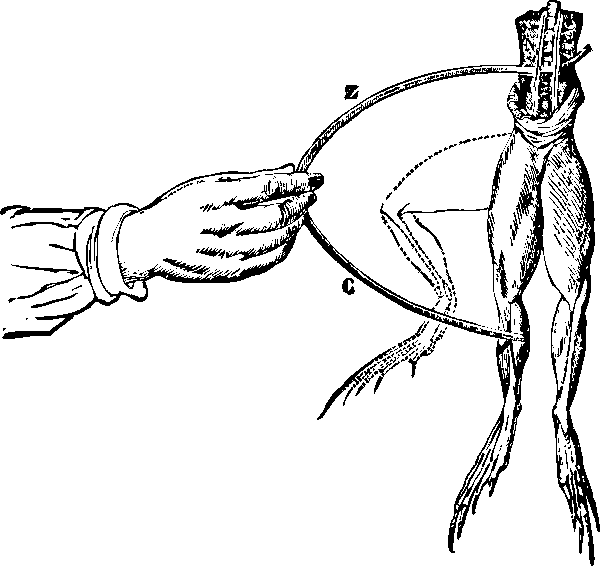
 In 1872, T. Green described cardiorespiratory resuscitation, a
method used to resuscitate surgical patients who were anesthetized with
chloroform, an anesthetic with the side effect of depressing respiration and the
cardiac pulse. Using a battery of up to 200 cells generating about 300 volts, he
applied this voltage to the patient between the neck and the lower ribs on the
left side. It is documented that T. Green used this method successfully on five
or seven patients who suffered sudden respiratory arrest and were without a
pulse (Green, 1872).
In 1872, T. Green described cardiorespiratory resuscitation, a
method used to resuscitate surgical patients who were anesthetized with
chloroform, an anesthetic with the side effect of depressing respiration and the
cardiac pulse. Using a battery of up to 200 cells generating about 300 volts, he
applied this voltage to the patient between the neck and the lower ribs on the
left side. It is documented that T. Green used this method successfully on five
or seven patients who suffered sudden respiratory arrest and were without a
pulse (Green, 1872).  Michael Faraday's invention of the induction coil in 1831
initiated the faradic era of electromedicine (Faraday, 1834). However, it was
Emil Heinrich du Bois-Reymond (German; 1818-96), who in 1846 introduced the
induction coil to medical applications (du Bois-Reymond, 1849). This was called
the Faraday stimulation. An induction coil with hammer break is shown in
Figure 1.10. An early experiment of Faraday stimulation of the cerebral cortex
was made in 1874 by Dr. Robert Bartholow, a professor of medicine in Cincinnati
(Bartholow, 1881). Robert Bartholow stimulated the exposed cerebral cortex with
faradic currents and observed that they would elicit movements of the limbs of
the opposite side and also the turning of the head to that side (York, 1987).
Michael Faraday's invention of the induction coil in 1831
initiated the faradic era of electromedicine (Faraday, 1834). However, it was
Emil Heinrich du Bois-Reymond (German; 1818-96), who in 1846 introduced the
induction coil to medical applications (du Bois-Reymond, 1849). This was called
the Faraday stimulation. An induction coil with hammer break is shown in
Figure 1.10. An early experiment of Faraday stimulation of the cerebral cortex
was made in 1874 by Dr. Robert Bartholow, a professor of medicine in Cincinnati
(Bartholow, 1881). Robert Bartholow stimulated the exposed cerebral cortex with
faradic currents and observed that they would elicit movements of the limbs of
the opposite side and also the turning of the head to that side (York, 1987).
 In the late
1800s, Jacques Arsène d'Arsonval heated living tissue by applying high-frequency
electric current either with an electrode or with a large coil (see Figure 1.11)
(d'Arsonval, 1893). This was the beginning of diathermy.
In the late
1800s, Jacques Arsène d'Arsonval heated living tissue by applying high-frequency
electric current either with an electrode or with a large coil (see Figure 1.11)
(d'Arsonval, 1893). This was the beginning of diathermy.  Jacques d'Arsonval
(1896) reported on a flickering visual sensation perceived when an individual's
head was placed within a strong time-varying magnetic field. This was generated
with a large coil carrying 32 A at 42 Hz. He called this phenomenon
"magnetophosphenes." It was caused by the stimulating effect of the
magnetic field to the retina, which is known to be very sensitive to it. This
was the first experiment on magnetic stimulation of the nervous system. The
first transcranial magnetic stimulation of the motor cortex was achieved
in 1985 (Barker, Jalinous, and Freeston, 1985)..
Jacques d'Arsonval
(1896) reported on a flickering visual sensation perceived when an individual's
head was placed within a strong time-varying magnetic field. This was generated
with a large coil carrying 32 A at 42 Hz. He called this phenomenon
"magnetophosphenes." It was caused by the stimulating effect of the
magnetic field to the retina, which is known to be very sensitive to it. This
was the first experiment on magnetic stimulation of the nervous system. The
first transcranial magnetic stimulation of the motor cortex was achieved
in 1985 (Barker, Jalinous, and Freeston, 1985)..
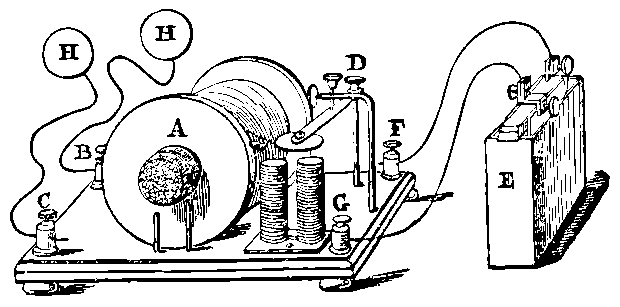
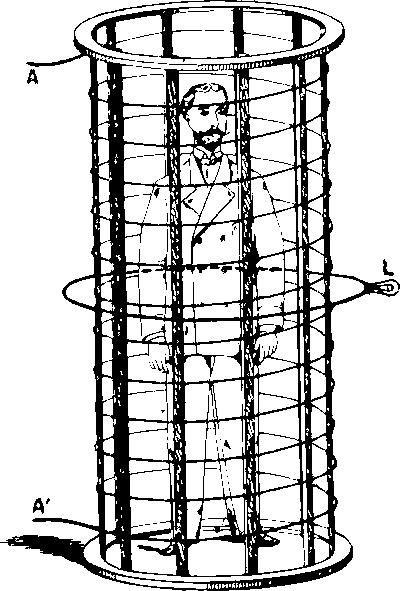
Fig. 1.11. d'Arsonval's great solenoid. (d'Arsonval, 1893).
 The first scientist to report direct cardiac pacing was F.
Steiner (1871), who demonstrated this method in a dog anesthetized with an
overdose of chloroform. In 1882, Hugo Wilhelm von Ziemssen (German; 1829-1902)
applied this technique to a human (Ziemssen, 1882). It was only in 1932, when
cardiac pacing was reported by Albert Salisbury Hyman (American; 1893-1972),
that this method was applied clinically to atrial pacing (Hyman, 1932).
The first scientist to report direct cardiac pacing was F.
Steiner (1871), who demonstrated this method in a dog anesthetized with an
overdose of chloroform. In 1882, Hugo Wilhelm von Ziemssen (German; 1829-1902)
applied this technique to a human (Ziemssen, 1882). It was only in 1932, when
cardiac pacing was reported by Albert Salisbury Hyman (American; 1893-1972),
that this method was applied clinically to atrial pacing (Hyman, 1932).  The modern era of
cardiac pacing started in August 1952, when Paul Maurice Zoll (American; 1911- )
performed cardiac pacing for a duration of 20 min (Zoll, 1952). In 1958, Furman
and Schwedel succeeded in supporting a patient for 96 days with cardiac pacing
(Furman and Schwedel, 1959).
The modern era of
cardiac pacing started in August 1952, when Paul Maurice Zoll (American; 1911- )
performed cardiac pacing for a duration of 20 min (Zoll, 1952). In 1958, Furman
and Schwedel succeeded in supporting a patient for 96 days with cardiac pacing
(Furman and Schwedel, 1959).  The first implantation
of a cardiac pacemaker, a milestone in the history of bioelectromagnetism, was
accomplished in Stockholm by the surgeon Åke Senning (1915- ). On October 8,
1958, at the Karolinska Institute, he implanted the pacemaker made by engineer
Rune Elmqvist. The development of the implantable pacemaker was made possible by
the invention of the transistor by Bardeen and Brattain in 1948.
The first implantation
of a cardiac pacemaker, a milestone in the history of bioelectromagnetism, was
accomplished in Stockholm by the surgeon Åke Senning (1915- ). On October 8,
1958, at the Karolinska Institute, he implanted the pacemaker made by engineer
Rune Elmqvist. The development of the implantable pacemaker was made possible by
the invention of the transistor by Bardeen and Brattain in 1948.  The first report on
cardiac defibrillation, in 1899, is that by Jean Louis Prevost (Swiss;
1838-1927) and Frédéric Battelli (Italian; 1867-1941) (Prevost and Battelli,
1899). They found, in animal experiments, that low-voltage electric shocks
induced ventricular fibrillation whereas high-voltage shocks did not. Instead,
the latter defibrillated a fibrillating heart.
The first report on
cardiac defibrillation, in 1899, is that by Jean Louis Prevost (Swiss;
1838-1927) and Frédéric Battelli (Italian; 1867-1941) (Prevost and Battelli,
1899). They found, in animal experiments, that low-voltage electric shocks
induced ventricular fibrillation whereas high-voltage shocks did not. Instead,
the latter defibrillated a fibrillating heart.  Modern ventricular
defibrillation started with the famous work of William B. Kouwenhoven (American;
1886-1975) and his colleagues who, in the 1930s, used 60 Hz current to
defibrillate a dog heart (Geddes, 1976). The first human defibrillation was
accomplished by Beck and his colleagues in 1947 (Beck, Pritchard and Feil,
1947).
Modern ventricular
defibrillation started with the famous work of William B. Kouwenhoven (American;
1886-1975) and his colleagues who, in the 1930s, used 60 Hz current to
defibrillate a dog heart (Geddes, 1976). The first human defibrillation was
accomplished by Beck and his colleagues in 1947 (Beck, Pritchard and Feil,
1947).
 After this discovery, it was possible to devise a galvanometer,
an instrument detecting weak electric currents. Invented by Johann Salemo
Christopf Schweigger (German; 1779-1875) in 1821, it is based on the deflection
of a magnetized needle in the magnetic field inside a coil, into which the
current to be measured is introduced. Because he increased the magnetic field by
using multiple loops of wire forming the coil, Schweigger called his instrument
multiplikator (Schweigger, 1821). In 1825, Leopold Nobili (Italian;
1784-1835), a professor of physics in Florence, invented the astatic
galvanometer (Nobili, 1825). In its construction, Nobili employed a double
coil of 72 turns wound in a figure eight (see Figure 1.13A). One magnetic needle
was located in each of the two openings. The needles were connected on the same
suspension. They were parallel, but of opposite polarity. Since the current
flowed in opposite direction in the two coils, both needles moved in the same
direction. Because of their opposite direction, the needles did not respond to
Earth's magnetic field. Another version of the astatic galvanometer is
illustrated in Figure 1.13B. This construction includes only one coil around one
of the two magnetic needles. The other needle (identical but opposite in
direction), provided with a scale, serves also as an indicator..
After this discovery, it was possible to devise a galvanometer,
an instrument detecting weak electric currents. Invented by Johann Salemo
Christopf Schweigger (German; 1779-1875) in 1821, it is based on the deflection
of a magnetized needle in the magnetic field inside a coil, into which the
current to be measured is introduced. Because he increased the magnetic field by
using multiple loops of wire forming the coil, Schweigger called his instrument
multiplikator (Schweigger, 1821). In 1825, Leopold Nobili (Italian;
1784-1835), a professor of physics in Florence, invented the astatic
galvanometer (Nobili, 1825). In its construction, Nobili employed a double
coil of 72 turns wound in a figure eight (see Figure 1.13A). One magnetic needle
was located in each of the two openings. The needles were connected on the same
suspension. They were parallel, but of opposite polarity. Since the current
flowed in opposite direction in the two coils, both needles moved in the same
direction. Because of their opposite direction, the needles did not respond to
Earth's magnetic field. Another version of the astatic galvanometer is
illustrated in Figure 1.13B. This construction includes only one coil around one
of the two magnetic needles. The other needle (identical but opposite in
direction), provided with a scale, serves also as an indicator..
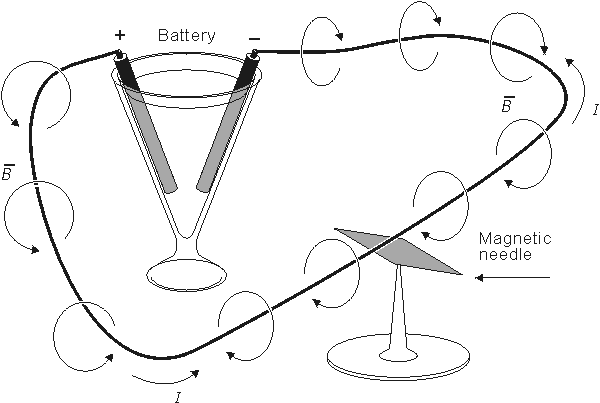
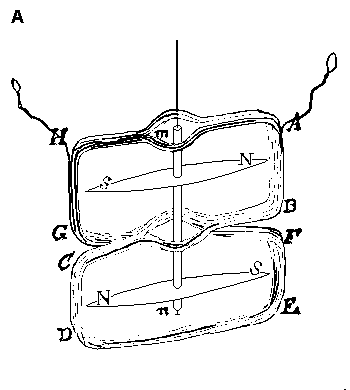
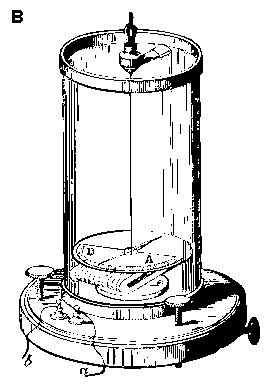
 Carlo Matteucci (Italian; 1811-65) was the first to measure a
bioelectric current. Using the astatic galvanometer, he made his first
measurement of muscle impulse in frog muscle in 1838 (Matteucci, 1838),
although the report did not appear in print until 1842.
Carlo Matteucci (Italian; 1811-65) was the first to measure a
bioelectric current. Using the astatic galvanometer, he made his first
measurement of muscle impulse in frog muscle in 1838 (Matteucci, 1838),
although the report did not appear in print until 1842.  In 1841, the German
physiologist Emil du Bois-Reymond had received a copy of Matteucci's short essay
on animal electricity, and thus was aware of the experiments of Matteucci. He
repeated the studies with improved instrumentation. Besides detecting the
bioelectric current from frog muscle, du Bois-Reymond, in 1842 (shortly before
Matteucci's paper was published), measured the current arising from a frog
nerve impulse (du Bois-Reymond, 1843). One of his experiments is shown in
Figure 1.14.
In 1841, the German
physiologist Emil du Bois-Reymond had received a copy of Matteucci's short essay
on animal electricity, and thus was aware of the experiments of Matteucci. He
repeated the studies with improved instrumentation. Besides detecting the
bioelectric current from frog muscle, du Bois-Reymond, in 1842 (shortly before
Matteucci's paper was published), measured the current arising from a frog
nerve impulse (du Bois-Reymond, 1843). One of his experiments is shown in
Figure 1.14.  The English school of neurophysiology began when Richard Caton
(British; 1842-1926) became interested in the recording technique of du
Bois-Reymond and applied it to the measurement of the electric activity of the
brains of rabbits and monkeys. The first report of his experiments, published in
1875 (Caton, 1875), is believed to constitute the discovery of the
electroencephalogram (EEG). In 1888, a young Polish scientist Adolf Beck
(1863- 1942), working for the great physiologist Napoleon Nicodemus Cybulski
(1854-1919) at the University of Krakow, succeeded in demonstrating that the
electric impulse propagated along a nerve fiber without attenuation (Beck,
1888). Without knowledge of the work of Caton, Beck studied the electric
activity of the brain in animal experiments and independently arrived at many of
Caton's conclusions (Beck, 1891). The German psychiatrist Hans Berger
(1873-1941), made the first recording of the EEG on a human in 1924, and
identified the two major rhythms, and (Berger, 1929). Berger's recordings on EEG
are illustrated in Figure 1.15.
The English school of neurophysiology began when Richard Caton
(British; 1842-1926) became interested in the recording technique of du
Bois-Reymond and applied it to the measurement of the electric activity of the
brains of rabbits and monkeys. The first report of his experiments, published in
1875 (Caton, 1875), is believed to constitute the discovery of the
electroencephalogram (EEG). In 1888, a young Polish scientist Adolf Beck
(1863- 1942), working for the great physiologist Napoleon Nicodemus Cybulski
(1854-1919) at the University of Krakow, succeeded in demonstrating that the
electric impulse propagated along a nerve fiber without attenuation (Beck,
1888). Without knowledge of the work of Caton, Beck studied the electric
activity of the brain in animal experiments and independently arrived at many of
Caton's conclusions (Beck, 1891). The German psychiatrist Hans Berger
(1873-1941), made the first recording of the EEG on a human in 1924, and
identified the two major rhythms, and (Berger, 1929). Berger's recordings on EEG
are illustrated in Figure 1.15.
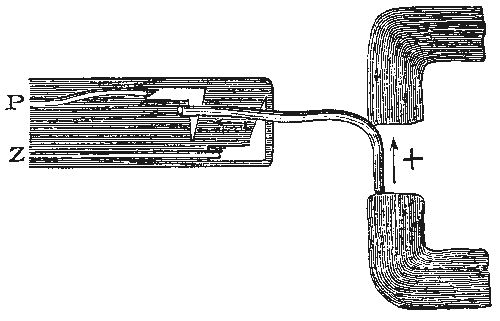
Fig. 1.14. Du Bois-Reymond's apparatus for studying effect of
continuous current on nerve..
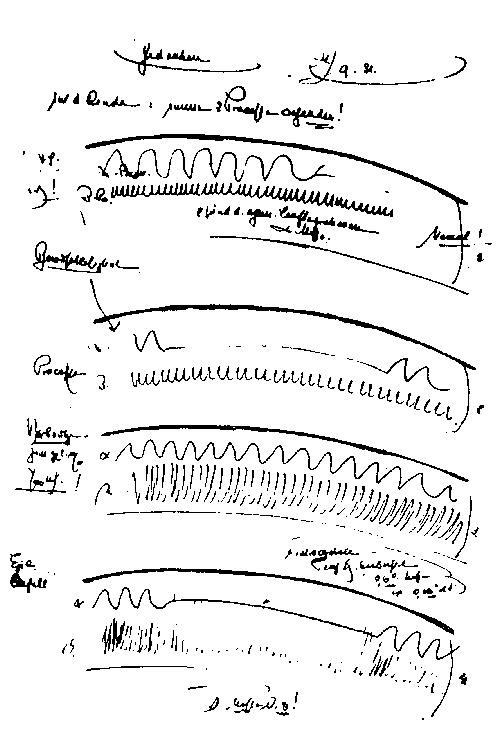
Fig. 1.15. A page from Berger's notebook illustrating early
recordings of the human EEG.
 Waller found that the cardiac electric generator has a dipolar
nature (Figure 1.17) and suggested that the ECG should be measured between
the five measurement points formed by the hands, legs, and mouth (a total of 10
bipolar leads). He was also the first to record a set of three nearly orthogonal
leads, including mouth-to-left arm, mouth-to-left leg, and back-to-front.
Waller found that the cardiac electric generator has a dipolar
nature (Figure 1.17) and suggested that the ECG should be measured between
the five measurement points formed by the hands, legs, and mouth (a total of 10
bipolar leads). He was also the first to record a set of three nearly orthogonal
leads, including mouth-to-left arm, mouth-to-left leg, and back-to-front.
 A pioneer in
modern electrocardiography was Willem Einthoven (Dutch; 1860-1927) who, at the
beginning of this century, developed the first high-quality ECG recorder based
on the string galvanometer (Einthoven, 1908). Though Einthoven is often
credited with inventing the string galvanometer, that honor actually belongs to
Clément Ader (1897). However, Einthoven undoubtedly made important improvements
in this device such that it was possible to apply it to clinical
electrocardiography. Einthoven summarized his fundamental results in ECG
research in 1908 and 1913 (Einthoven, 1908; Einthoven et al., 1913), and
received the Nobel Prize for his work in 1924.
A pioneer in
modern electrocardiography was Willem Einthoven (Dutch; 1860-1927) who, at the
beginning of this century, developed the first high-quality ECG recorder based
on the string galvanometer (Einthoven, 1908). Though Einthoven is often
credited with inventing the string galvanometer, that honor actually belongs to
Clément Ader (1897). However, Einthoven undoubtedly made important improvements
in this device such that it was possible to apply it to clinical
electrocardiography. Einthoven summarized his fundamental results in ECG
research in 1908 and 1913 (Einthoven, 1908; Einthoven et al., 1913), and
received the Nobel Prize for his work in 1924.  Horatio Williams, who
was the first to construct a sequence of instantaneous vectors (Williams, 1914),
is usually considered to be the inventor of vectorcardiography. Hubert
Mann made further studies in vectorcardiography to develop it as a clinical
tool. He published his first two-dimensional vectorcardiogram based on
Einthoven's triangle in 1916 (see Figure 1.18) and called this construction the
"monocardiogram" (Mann, 1920). After J. B. Johnson (1921) of the Western
Electric Company invented the low-voltage cathode ray tube, it became possible
to display bioelectric signals in vector form in real time. This invention
allowed vectorcardiography to be used as a clinical tool.
Horatio Williams, who
was the first to construct a sequence of instantaneous vectors (Williams, 1914),
is usually considered to be the inventor of vectorcardiography. Hubert
Mann made further studies in vectorcardiography to develop it as a clinical
tool. He published his first two-dimensional vectorcardiogram based on
Einthoven's triangle in 1916 (see Figure 1.18) and called this construction the
"monocardiogram" (Mann, 1920). After J. B. Johnson (1921) of the Western
Electric Company invented the low-voltage cathode ray tube, it became possible
to display bioelectric signals in vector form in real time. This invention
allowed vectorcardiography to be used as a clinical tool.  The invention of the
electron tube by Lee de Forest (American: 1873-1961) in 1906 allowed
bioelectric signals to be amplified, revolutionizing measurement technology.
Finally, the invention of the transistor by John Bardeen and Walter Brattain in
1948 marked the beginning of the semiconductor era. It also allowed the
instrumentation of bioelectromagnetism to be miniaturized, made portable and
implantable, and more reliable.
The invention of the
electron tube by Lee de Forest (American: 1873-1961) in 1906 allowed
bioelectric signals to be amplified, revolutionizing measurement technology.
Finally, the invention of the transistor by John Bardeen and Walter Brattain in
1948 marked the beginning of the semiconductor era. It also allowed the
instrumentation of bioelectromagnetism to be miniaturized, made portable and
implantable, and more reliable.
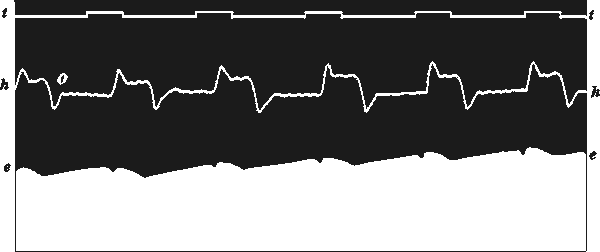
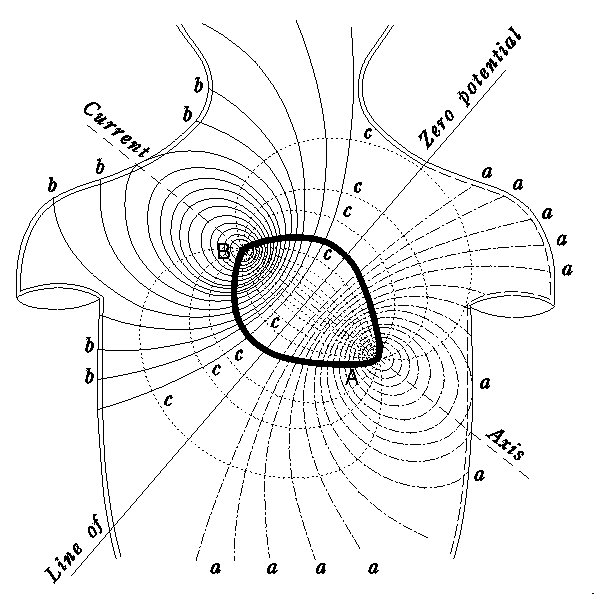

 Sir Charles Scott
Sherrington (British; 1856-1952) introduced the concept of the synapse
(Sherrington, 1897). He also contributed the concept of the reflex arc.
Lord Edgar Douglas Adrian (British; 1889-1977) formulated the
all-or-nothing law of the neural cell in 1912 (Adrian and Lucas,
1912; Adrian, 1914) and measured the electric impulse of a single nerve 1926.
Adrian and Sherrington won the Nobel Prize in 1932.
Sir Charles Scott
Sherrington (British; 1856-1952) introduced the concept of the synapse
(Sherrington, 1897). He also contributed the concept of the reflex arc.
Lord Edgar Douglas Adrian (British; 1889-1977) formulated the
all-or-nothing law of the neural cell in 1912 (Adrian and Lucas,
1912; Adrian, 1914) and measured the electric impulse of a single nerve 1926.
Adrian and Sherrington won the Nobel Prize in 1932.  The founder of
membrane theory was Julius Bernstein (German; 1839-1917), a pupil of Hermann von
Helmholtz. Bernstein stated that the potential difference across the membrane
was maintained by the difference in concentration of potassium ions on opposite
sides of the membrane. The membrane, which is selectively permeable to all ions,
has a particularly high permeability to potassium. This formed the basis for an
evaluation of the transmembrane voltage as proportional to the logarithm of the
concentration ratio of the potassium ions, as expressed by the Nernst
equation.
The founder of
membrane theory was Julius Bernstein (German; 1839-1917), a pupil of Hermann von
Helmholtz. Bernstein stated that the potential difference across the membrane
was maintained by the difference in concentration of potassium ions on opposite
sides of the membrane. The membrane, which is selectively permeable to all ions,
has a particularly high permeability to potassium. This formed the basis for an
evaluation of the transmembrane voltage as proportional to the logarithm of the
concentration ratio of the potassium ions, as expressed by the Nernst
equation.  Herbert Spencer Gasser (American; 1888-1963) and Joseph Erlanger
(American; 1874-1965) studied nerve impulses with the aid of a cathode ray tube.
Because they could not get a cathode-ray oscilloscope from the Western
Electric Company, which had recently invented it, they built such a device
themselves from a distillation flask. Linking the device to an amplifier, they
could record the time course of nerve impulses for the first time (Gasser and
Erlanger, 1922). With their experiments they were also able to confirm the
hypothesis that axons of large diameter within a nerve bundle transmit nerve
impulses more quickly than do thin axons. For their studies Gasser and Erlanger
received the Nobel Prize in 1944.
Herbert Spencer Gasser (American; 1888-1963) and Joseph Erlanger
(American; 1874-1965) studied nerve impulses with the aid of a cathode ray tube.
Because they could not get a cathode-ray oscilloscope from the Western
Electric Company, which had recently invented it, they built such a device
themselves from a distillation flask. Linking the device to an amplifier, they
could record the time course of nerve impulses for the first time (Gasser and
Erlanger, 1922). With their experiments they were also able to confirm the
hypothesis that axons of large diameter within a nerve bundle transmit nerve
impulses more quickly than do thin axons. For their studies Gasser and Erlanger
received the Nobel Prize in 1944.  Sir Alan Lloyd Hodgkin
(English; 1914- ) and Sir Andrew Fielding Huxley (English; 1914- ) investigated
the behavior of the cell membrane in great detail and developed a very accurate
mathematical model of the activation process (Hodgkin and Huxley, 1952). Sir
John Eccles (Australian; 1903- ) investigated synaptic transmission in Canberra,
Australia, in the 1950s. Eccles, Hodgkin, and Huxley won the Nobel Prize in
1963.
Sir Alan Lloyd Hodgkin
(English; 1914- ) and Sir Andrew Fielding Huxley (English; 1914- ) investigated
the behavior of the cell membrane in great detail and developed a very accurate
mathematical model of the activation process (Hodgkin and Huxley, 1952). Sir
John Eccles (Australian; 1903- ) investigated synaptic transmission in Canberra,
Australia, in the 1950s. Eccles, Hodgkin, and Huxley won the Nobel Prize in
1963.  Ragnar
Arthur Granit (Finnish; 1900-1991) undertook fundamental research in the
bioelectric phenomena of the retina and the nervous system in the 1930s and
1940s. In 1935, he could show experimentally that inhibitory synapses are found
in the retina. Hermann von Helmholtz had proposed that the human ability to
discriminate a spectrum of colors could be explained if it could be proven that
the eye contains receptors sensitive to different wavelengths of light. Granit's
first experiments in color vision, performed in 1937, employed the
electroretinogram (ERG) to confirm the extent of spectral differentiation. In
1939, Granit developed a microelectrode, a device that permits the measurement
of electric potentials inside a cell. With this technique Granit further studied
the color vision and established the spectral sensitivities of the three types
of cone cells - blue, green, and red. Ragnar Granit shared the 1967 Nobel Prize
with H. Keffer Hartline and George Wald "for their discoveries concerning the
primary physiological and chemical visual processes in the eye." (Granit, 1955)
Ragnar
Arthur Granit (Finnish; 1900-1991) undertook fundamental research in the
bioelectric phenomena of the retina and the nervous system in the 1930s and
1940s. In 1935, he could show experimentally that inhibitory synapses are found
in the retina. Hermann von Helmholtz had proposed that the human ability to
discriminate a spectrum of colors could be explained if it could be proven that
the eye contains receptors sensitive to different wavelengths of light. Granit's
first experiments in color vision, performed in 1937, employed the
electroretinogram (ERG) to confirm the extent of spectral differentiation. In
1939, Granit developed a microelectrode, a device that permits the measurement
of electric potentials inside a cell. With this technique Granit further studied
the color vision and established the spectral sensitivities of the three types
of cone cells - blue, green, and red. Ragnar Granit shared the 1967 Nobel Prize
with H. Keffer Hartline and George Wald "for their discoveries concerning the
primary physiological and chemical visual processes in the eye." (Granit, 1955)
 The behavior
of ion channels in the biological membrane has been described in greater detail
through the invention of the patch clamp technique by Erwin Neher
(German; 1944- ) and Bert Sakmann (German; 1942- ) (Neher and Sakmann, 1976).
With the patch clamp method it is possible to measure the electric current from
a single ionic channel. This extends the origins of bioelectromagnetism to
molecular biology so that this technique can also be used, for instance, in
developing new pharmaceuticals. Neher and Sakmann won the Nobel Prize in 1991.
The behavior
of ion channels in the biological membrane has been described in greater detail
through the invention of the patch clamp technique by Erwin Neher
(German; 1944- ) and Bert Sakmann (German; 1942- ) (Neher and Sakmann, 1976).
With the patch clamp method it is possible to measure the electric current from
a single ionic channel. This extends the origins of bioelectromagnetism to
molecular biology so that this technique can also be used, for instance, in
developing new pharmaceuticals. Neher and Sakmann won the Nobel Prize in 1991.
 The first biomagnetic signal, the magnetocardiogram (MCG), was
detected by Gerhard M. Baule and Richard McFee in 1963 with an induction coil
magnetometer (Baule and McFee, 1963). The magnetometer was made by winding two
million turns of copper wire around a ferrite core. In addition to the detector
coil, which was placed in front of the heart, another identical coil was
connected in series and placed alongside. The two coils had opposite senses and
thereby canceled the distributing common magnetic fields arising from distant
external sources (see Figure 1.19). A remarkable increase in the sensitivity of
biomagnetic measurements was obtained with the introduction of the
Superconducting QUantum Interference Device (SQUID), working at the
temperature of liquid helium (-269 C) (Zimmerman, Thiene, and Hardings, 1970;
Cohen, 1972).
The first biomagnetic signal, the magnetocardiogram (MCG), was
detected by Gerhard M. Baule and Richard McFee in 1963 with an induction coil
magnetometer (Baule and McFee, 1963). The magnetometer was made by winding two
million turns of copper wire around a ferrite core. In addition to the detector
coil, which was placed in front of the heart, another identical coil was
connected in series and placed alongside. The two coils had opposite senses and
thereby canceled the distributing common magnetic fields arising from distant
external sources (see Figure 1.19). A remarkable increase in the sensitivity of
biomagnetic measurements was obtained with the introduction of the
Superconducting QUantum Interference Device (SQUID), working at the
temperature of liquid helium (-269 C) (Zimmerman, Thiene, and Hardings, 1970;
Cohen, 1972).  Although David Cohen succeeded to measure the magnetic alpha rhythm
with an induction coil magnetometer (Cohen, 1968), the magnetic signal generated
by the electric activity of the brain, measured in the
magnetoencephalogram (MEG), is so low that in practice its detection is
possible only by using the SQUID. With such a device the MEG was first detected
by David Cohen in 1970 (Cohen, 1972). John Wikswo and his co-workers were first
to measure the magnetic field of a frog nerve bundle in 1980 (Wikswo, Barach,
and Freeman, 1980).
Although David Cohen succeeded to measure the magnetic alpha rhythm
with an induction coil magnetometer (Cohen, 1968), the magnetic signal generated
by the electric activity of the brain, measured in the
magnetoencephalogram (MEG), is so low that in practice its detection is
possible only by using the SQUID. With such a device the MEG was first detected
by David Cohen in 1970 (Cohen, 1972). John Wikswo and his co-workers were first
to measure the magnetic field of a frog nerve bundle in 1980 (Wikswo, Barach,
and Freeman, 1980).  In this connection we want to draw the readers' attention to the fact
that the difference between the measurement principles in the first measurements
of the bioelectric and biomagnetic signals is surprisingly small:
In this connection we want to draw the readers' attention to the fact
that the difference between the measurement principles in the first measurements
of the bioelectric and biomagnetic signals is surprisingly small:  In the first
measurement of the bioelectric signal, Matteucci (1838) used a magnetized
needle as the detector. (The bioelectric field is, of course, far too low to
deflect the needle of an electroscope.) The biomagnetic field, produced by the
bioelectric currents flowing in the frog leg, was too small to deflect the
magnetic needle directly. It was therefore multiplied by feeding the bioelectric
current to a coil of multiple turns and with placement of the needle inside the
coil, an application of the invention of Schweigger (1821). The effect of the
Earth's magnetic field was compensated by winding the coil in the form of a
figure eight, placing two identical magnetic needles on the same suspension and
oriented in opposite directions in the two openings of the coil. This formed an
astatic galvanometer, as described earlier.
In the first
measurement of the bioelectric signal, Matteucci (1838) used a magnetized
needle as the detector. (The bioelectric field is, of course, far too low to
deflect the needle of an electroscope.) The biomagnetic field, produced by the
bioelectric currents flowing in the frog leg, was too small to deflect the
magnetic needle directly. It was therefore multiplied by feeding the bioelectric
current to a coil of multiple turns and with placement of the needle inside the
coil, an application of the invention of Schweigger (1821). The effect of the
Earth's magnetic field was compensated by winding the coil in the form of a
figure eight, placing two identical magnetic needles on the same suspension and
oriented in opposite directions in the two openings of the coil. This formed an
astatic galvanometer, as described earlier.  In the first
measurement of a biomagnetic signal (the magnetocardiogram), the
magnetic field produced by the bioelectric currents circulating in the human
body was measured with a coil (Baule and McFee, 1963). Because of the low
amplitude of this biomagnetic field, multiple turns of wire had to be wound
around the core of the coil. To compensate for the effect of the magnetic field
of the Earth and other sources of "noise", two identical coils wound in opposite
directions were used (Figure 1.19).
In the first
measurement of a biomagnetic signal (the magnetocardiogram), the
magnetic field produced by the bioelectric currents circulating in the human
body was measured with a coil (Baule and McFee, 1963). Because of the low
amplitude of this biomagnetic field, multiple turns of wire had to be wound
around the core of the coil. To compensate for the effect of the magnetic field
of the Earth and other sources of "noise", two identical coils wound in opposite
directions were used (Figure 1.19).  Thus, in terms of
measurement technology, the first measurements of bioelectric and biomagnetic
signals can be discriminated on the basis of whether the primary loop of the
conversion of the bioelectric current to a magnetic field takes place outside or
within the body, respectively. Since the invention of the capillary electrometer
by G. J. Lippman (1873) and especially after the invention of electronic
amplifiers, electric measurements have not directly utilized induced magnetic
fields, and therefore the techniques of bioelectric and biomagnetic measurements
have been driven apart.
Thus, in terms of
measurement technology, the first measurements of bioelectric and biomagnetic
signals can be discriminated on the basis of whether the primary loop of the
conversion of the bioelectric current to a magnetic field takes place outside or
within the body, respectively. Since the invention of the capillary electrometer
by G. J. Lippman (1873) and especially after the invention of electronic
amplifiers, electric measurements have not directly utilized induced magnetic
fields, and therefore the techniques of bioelectric and biomagnetic measurements
have been driven apart.  In terms of
measurement theory, the first measurements of bioelectric signals were
measurements of the flow source, and thus truly electric. The first
measurement of the biomagnetic signal by Richard McFee was the measurement of
the vortex source, and thus truly magnetic. It will be shown later that
with magnetic detectors it is possible to make a measurement which resembles the
detection of the flow source. However, such a measurment does not give new
informaion about the source compared to the electric measurement.
In terms of
measurement theory, the first measurements of bioelectric signals were
measurements of the flow source, and thus truly electric. The first
measurement of the biomagnetic signal by Richard McFee was the measurement of
the vortex source, and thus truly magnetic. It will be shown later that
with magnetic detectors it is possible to make a measurement which resembles the
detection of the flow source. However, such a measurment does not give new
informaion about the source compared to the electric measurement.  This example should
draw our readers' attention to the fact that from a theoretical point of
view, the essential difference between the bioelectric and biomagnetic
measurements lies in the sensitivity distributions of these methods.
Another difference stems from the diverse technical properties of these
instrumentations, which impart to either method specific advantages in certain
applications..
This example should
draw our readers' attention to the fact that from a theoretical point of
view, the essential difference between the bioelectric and biomagnetic
measurements lies in the sensitivity distributions of these methods.
Another difference stems from the diverse technical properties of these
instrumentations, which impart to either method specific advantages in certain
applications..
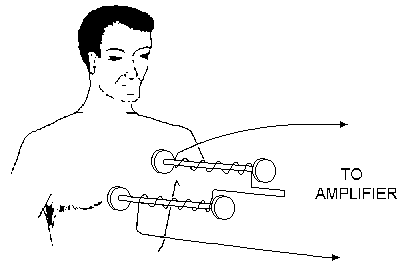
Fig. 1.19. Detection of the first biomagnetic signal, the
magnetocardiogram (MCG), by Baule and McFee. (Redrawn from Baule and McFee,
1963.).
 Helmholtz's
fundamental experimental and theoretical scientific contributions in the field
of bioelectromagnetism include the following topics, which are included in this
book:
Helmholtz's
fundamental experimental and theoretical scientific contributions in the field
of bioelectromagnetism include the following topics, which are included in this
book:
1. The demonstration that axons are processes of nerve cell bodies
(1842)
2. The establishment of the law of conservation of energy (the
First Law of Thermodynamics) (1847)
3. The invention of the
myograph and the first measurement of the conduction velocity of
a motor nerve axon (1850)
4. The concept of double layer source
(1853)
5. The solid angle theorem for electric potentials
6. The
principle of superposition (1853)
7. The reciprocity theorem
(1853)
8. The insolvability of the inverse problem (1853)
9.
Helmholtz's theorem concerning the independence of flow and vortex
sources
10. The Helmholtz coils (applied in biomagnetic
instrumentation) Besides these, the contributions of Helmholtz to other fields of
science include fundamental works in physiology, acoustics, optics,
electrodynamics, thermodynamics, and meteorology. He is the author of the
theory of hearing (1863) from which all modern theories of resonance are
derived. He also invented, in 1851, the ophthalmoscope, which is used to
investigate the retina of a living eye.
Besides these, the contributions of Helmholtz to other fields of
science include fundamental works in physiology, acoustics, optics,
electrodynamics, thermodynamics, and meteorology. He is the author of the
theory of hearing (1863) from which all modern theories of resonance are
derived. He also invented, in 1851, the ophthalmoscope, which is used to
investigate the retina of a living eye.  Until the end of the
nineteenth century, the physics of electricity was not fully understood. It was
known, however, that neither pure water nor dry salts could by themselves
transmit an electric current, whereas in aqueous solution salts could. Svante
August Arrhenius (Swedish; 1859-1927) hypothesized in his (1884) doctoral thesis
that molecules of some substances dissociate, or split, into two or more
particles (ions) when they are dissolved in a liquid. Although each
intact molecule is electrically balanced, the particles carry an electric
charge, either positive or negative depending on the nature of the particle.
These charged bodies form only in solution and permit the passage of
electricity. This theory is fundamental for understanding the nature of the
bioelectric current, because it flows in solutions and is carried by ions.
Svante Arrhenius won the Nobel Prize in Chemistry in 1903.
Until the end of the
nineteenth century, the physics of electricity was not fully understood. It was
known, however, that neither pure water nor dry salts could by themselves
transmit an electric current, whereas in aqueous solution salts could. Svante
August Arrhenius (Swedish; 1859-1927) hypothesized in his (1884) doctoral thesis
that molecules of some substances dissociate, or split, into two or more
particles (ions) when they are dissolved in a liquid. Although each
intact molecule is electrically balanced, the particles carry an electric
charge, either positive or negative depending on the nature of the particle.
These charged bodies form only in solution and permit the passage of
electricity. This theory is fundamental for understanding the nature of the
bioelectric current, because it flows in solutions and is carried by ions.
Svante Arrhenius won the Nobel Prize in Chemistry in 1903.  At the end of the
nineteenth century, Walther Hermann Nernst (German; 1864-1941) did fundamental
work in thermochemistry, investigating the behavior of electrolytes in the
presence of electric currents. In 1889, he developed a fundamental law, known as
the Nernst equation. Nernst also developed many other fundamental laws,
including the Third Law of Thermodynamics. He was awarded the Nobel Prize in
Chemistry in 1920.
At the end of the
nineteenth century, Walther Hermann Nernst (German; 1864-1941) did fundamental
work in thermochemistry, investigating the behavior of electrolytes in the
presence of electric currents. In 1889, he developed a fundamental law, known as
the Nernst equation. Nernst also developed many other fundamental laws,
including the Third Law of Thermodynamics. He was awarded the Nobel Prize in
Chemistry in 1920.  Dutch scientists Hermann Carel Burger (1893-1965) and Johan Bernhard
van Milaan (1886-1965) introduced the concept of the lead vector in 1946 (Burger
and van Milaan, 1946). They also extended this to the concept of the image
surface. In 1953, Richard McFee and Franklin D. Johnston introduced the
important concept of the lead field, which is based on the reciprocity
theorem of Helmholtz (McFee and Johnston, 1953, 1954ab). The invention of the
electromagnetic connection in 1819 by Örsted tied bioelectric and biomagnetic
fields together. The invention of the reciprocity theorem in 1853 by Helmholtz
showed that the sensitivity distribution of a lead for measuring bioelectric
sources is the same as the distribution of stimulation current introduced into
the same lead. Furthermore, this is the same as the sensitivity distribution of
a tissue impedance measurement with the same lead. All this is true for
corresponding magnetic methods as well. These principles are easily illustrated
with the concept of lead field.
Dutch scientists Hermann Carel Burger (1893-1965) and Johan Bernhard
van Milaan (1886-1965) introduced the concept of the lead vector in 1946 (Burger
and van Milaan, 1946). They also extended this to the concept of the image
surface. In 1953, Richard McFee and Franklin D. Johnston introduced the
important concept of the lead field, which is based on the reciprocity
theorem of Helmholtz (McFee and Johnston, 1953, 1954ab). The invention of the
electromagnetic connection in 1819 by Örsted tied bioelectric and biomagnetic
fields together. The invention of the reciprocity theorem in 1853 by Helmholtz
showed that the sensitivity distribution of a lead for measuring bioelectric
sources is the same as the distribution of stimulation current introduced into
the same lead. Furthermore, this is the same as the sensitivity distribution of
a tissue impedance measurement with the same lead. All this is true for
corresponding magnetic methods as well. These principles are easily illustrated
with the concept of lead field.  Dennis Gabor (British;
1900-1979) and Clifford V. Nelson published the Gabor-Nelson theorem in
1954 (Gabor and Nelson, 1954). This theorem explains how an equivalent dipole of
a volume source and its location may be calculated from measurements on the
surface of a homogeneous volume conductor.
Dennis Gabor (British;
1900-1979) and Clifford V. Nelson published the Gabor-Nelson theorem in
1954 (Gabor and Nelson, 1954). This theorem explains how an equivalent dipole of
a volume source and its location may be calculated from measurements on the
surface of a homogeneous volume conductor.
 1. Up to the middle of the nineteenth century, the history of
electromagnetism has actually also been the history of
bioelectromagnetism. The first electric machines and the Leyden jar were
constructed to produce static electricity for a specific purpose: to "electrify"
and to stimulate humans. The Voltaic pile was developed with the idea of
galvanic stimulation. The universal principles of reciprocity and superposition
were introduced in connection with their application to bioelectromagnetism.
Bioelectric and biomagnetic measurements have also been the incentive for the
development of sensitive measurement instruments. The latter include not only
the astatic galvanometer, capillary electrometer, and string galvanometer of the
nineteenth century but also the low-voltage cathode ray tube and the SQUID in
the twentieth century. An understanding of the function of nerve cells and brain
and their simulation with electronic models has led to the development of a new
generation of computers: the neurocomputer. These events emphasize the
importance of bioelectromagnetism.
1. Up to the middle of the nineteenth century, the history of
electromagnetism has actually also been the history of
bioelectromagnetism. The first electric machines and the Leyden jar were
constructed to produce static electricity for a specific purpose: to "electrify"
and to stimulate humans. The Voltaic pile was developed with the idea of
galvanic stimulation. The universal principles of reciprocity and superposition
were introduced in connection with their application to bioelectromagnetism.
Bioelectric and biomagnetic measurements have also been the incentive for the
development of sensitive measurement instruments. The latter include not only
the astatic galvanometer, capillary electrometer, and string galvanometer of the
nineteenth century but also the low-voltage cathode ray tube and the SQUID in
the twentieth century. An understanding of the function of nerve cells and brain
and their simulation with electronic models has led to the development of a new
generation of computers: the neurocomputer. These events emphasize the
importance of bioelectromagnetism.  2. In the seventeenth
and early eighteenth centuries, it is surprising how quickly a new invention in
the field of bioelectromagnetism became the basis for still further applications
and new inventions, even in different countries, although travel and
communication were limited to the horse. As examples one may mention the
invention of the Leyden jar in Germany and the Netherlands in 1745 and 1746,
respectively, and its systematic application to human functional electric
stimulation in Italy in 1747. Another example is the invention of the
electromagnetic connection in 1819 in Denmark and the development of the
galvanometer in 1821 in Germany and the astatic galvanometer in 1825 in Italy.
2. In the seventeenth
and early eighteenth centuries, it is surprising how quickly a new invention in
the field of bioelectromagnetism became the basis for still further applications
and new inventions, even in different countries, although travel and
communication were limited to the horse. As examples one may mention the
invention of the Leyden jar in Germany and the Netherlands in 1745 and 1746,
respectively, and its systematic application to human functional electric
stimulation in Italy in 1747. Another example is the invention of the
electromagnetic connection in 1819 in Denmark and the development of the
galvanometer in 1821 in Germany and the astatic galvanometer in 1825 in Italy.
 3. On the
other hand, some inventions have been rediscovered, having been "forgotten" for
about 100 years. Exactly 100 years elapsed following the publication of the
reciprocity theorem before the lead field theory was introduced. The magnetic
stimulation of the motor cortex was developed almost 100 years after the
observation of magnetophosphenes. The time span from the first bioelectric
measurements to the first corresponding biomagnetic measurements has been, on
average, 100 years - quite a long time!
3. On the
other hand, some inventions have been rediscovered, having been "forgotten" for
about 100 years. Exactly 100 years elapsed following the publication of the
reciprocity theorem before the lead field theory was introduced. The magnetic
stimulation of the motor cortex was developed almost 100 years after the
observation of magnetophosphenes. The time span from the first bioelectric
measurements to the first corresponding biomagnetic measurements has been, on
average, 100 years - quite a long time!  4. Several fundamental
techniques used today in bioelectromagnetic instrumentation date back to the
earliest instruments. The astatic galvanometer of 1825 included an ingenious
method of compensation for the magnetic noise field. This principle was applied
to the first measurement of MCG in 1963. Actually the planar gradiometers,
applied in the multichannel MEG-instruments using SQUID, are constructed exactly
according to the same principle as the astatic galvanometer coil was more than
150 years ago. The basic clinical ECG leads - the limb leads - were invented 100
years ago by Waller. Similarly, Waller also introduced the dipole model to ECG,
and it still has a strong role in electro- and magnetocardiology.
4. Several fundamental
techniques used today in bioelectromagnetic instrumentation date back to the
earliest instruments. The astatic galvanometer of 1825 included an ingenious
method of compensation for the magnetic noise field. This principle was applied
to the first measurement of MCG in 1963. Actually the planar gradiometers,
applied in the multichannel MEG-instruments using SQUID, are constructed exactly
according to the same principle as the astatic galvanometer coil was more than
150 years ago. The basic clinical ECG leads - the limb leads - were invented 100
years ago by Waller. Similarly, Waller also introduced the dipole model to ECG,
and it still has a strong role in electro- and magnetocardiology.
 A more detailed review of the history of bioelectromagnetism can be
found in the following references: Brazier (1988), Geddes (1984ab), McNeal
(1977), Mottelay (1975), Rautaharju (1987, 1988), Rowbottom and Susskind (1984),
and Wasson (1987)..
A more detailed review of the history of bioelectromagnetism can be
found in the following references: Brazier (1988), Geddes (1984ab), McNeal
(1977), Mottelay (1975), Rautaharju (1987, 1988), Rowbottom and Susskind (1984),
and Wasson (1987)..
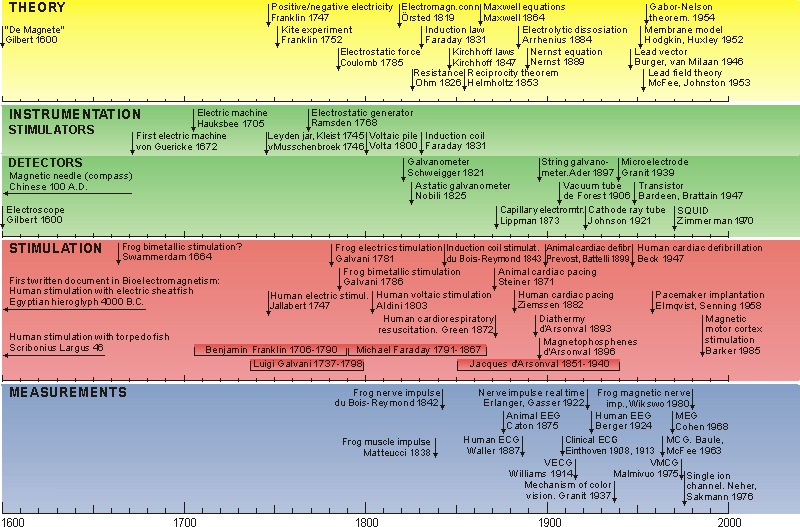
Fig. 1.20. Chronology of the history of bioelectromagnetism. The
historical events are divided into four groups: theory, instrumentation,
stimulation, and measurements..
 One should probably
add to this list the names of Gabriel Jonas Lippman and Dennis Gabor, although
they did not receive their Nobel Prize for their work in bioelectromagnetism.
One should probably
add to this list the names of Gabriel Jonas Lippman and Dennis Gabor, although
they did not receive their Nobel Prize for their work in bioelectromagnetism.
 Gabriel
Lippman received the Nobel Prize in physics in 1908 for his photographic
reproduction of colors. But he was also the inventor of the capillary
electrometer (Lippman, 1873). The capillary electrometer was a more sensitive
measuring instrument than the astatic galvanometer and was an important
contribution to the technology by which bioelectric events were recorded.
Gabriel
Lippman received the Nobel Prize in physics in 1908 for his photographic
reproduction of colors. But he was also the inventor of the capillary
electrometer (Lippman, 1873). The capillary electrometer was a more sensitive
measuring instrument than the astatic galvanometer and was an important
contribution to the technology by which bioelectric events were recorded.
 Dennis Gabor
received the Nobel Prize in physics in 1971 from the invention of holography. He
was also the senior author of the Gabor-Nelson theorem, which is used to
ascertain the equivalent dipole of a volume source by measurements of the
electric potential on the surface of the volume conductor (Gabor and Nelson,
1954).
Dennis Gabor
received the Nobel Prize in physics in 1971 from the invention of holography. He
was also the senior author of the Gabor-Nelson theorem, which is used to
ascertain the equivalent dipole of a volume source by measurements of the
electric potential on the surface of the volume conductor (Gabor and Nelson,
1954).  One
should also note that Georg von Békésy received the Nobel Prize for his
discoveries of the physical mechanism of stimulation within the cochlea.
His discoveries have, however, contributed most significantly to the analysis of
the relation between the mechanical and the electric phenomena in the receptors
involved in the transformation of sound into nerve impulses. Therefore, von
Békésy's name is included in this list..
One
should also note that Georg von Békésy received the Nobel Prize for his
discoveries of the physical mechanism of stimulation within the cochlea.
His discoveries have, however, contributed most significantly to the analysis of
the relation between the mechanical and the electric phenomena in the receptors
involved in the transformation of sound into nerve impulses. Therefore, von
Békésy's name is included in this list..
*) Nobel Prize in chemistry.
All other prizes were received in physiology or medicine.
Year
Name of recipient
Nationality
Subject of research
1901
Jacobus van't Hoff *)
The Netherlands
laws of chemical dynamics
and osmotic
pressure
1903
Svante Arrhenius *)
Sweden
theory of electrolytic
dissociation
1906
Camillo Golgi
Santiago Ramón y
Cajal Italy
Spainwork on the structure of
nervous system
1920
Walther Nernst *)
Germany
work in thermochemistry
1924
Willem Einthoven
The Netherlands
discovery of electro-
cardiogram mechanism
1932
Edgar Douglas Adrian
Sir Charles SherringtonBritain
Britaindiscoveries regarding
function of neurons
1936
Sir Henry Hallet Dale
Otto LoewiBritain
Germanywork on chemical trans-
mission of nerve impulses
1944
Joseph Erlanger
Herbert Spencer GasserU.S.
U.S.researches on differentiated
functions of nerve fibers
1949
Walter Rudolf Hess
Switzerland
discovery of function of
middle brain
1961
Georg von Békésy
U.S.
discoveries of the physical
mechanism of the inner ear
1963
Sir John Eccles
Alan Lloyd Hodgkin
Andrew Fielding
HuxleyAustralia
Britain
Britainstudy of the transmission
of nerve impulses along a
nerve
fibre
1967
Ragnar Arthur Granit
Haldan Keffer Hartline
George
WaldFinland
U.S.
U.S.discoveries about chemical
and physiological visual
processes in
the eye
1968
Lars Onsager *)
U.S.
work on theory of thermo-
dynamics of
irreversible
processes
1970
Julius Axelrod
Sir Bernard Katz
Ulf von EulerU.S.
Britain
Swedendiscoveries concerning the
chemistry of nerve
transmission
1981
David Hunter Hubel
Torsten Nils WieselU.S.
Swedendiscoveries concerning
information processing
in the visual
system
1991
Erwin Neher
Bert SakmannGermany
Germanydiscoveries concerning
the function of single
ion channels in
cells


